A Guide toIndian Dal, Lentils, Beans, and Pulses
Last Updated on January 8, 2024 by PujaSo many different Indian foods are made with lentils. From khichdi, made of simple rice and lentils, to dals, flatbreads, and some Maggie noodles are made from lentils. Beans and lentils are a primary source of protein for many vegetarians, and India is full of vegetarians.

What is Dal?
Dal is the word for “split pulse” commonly used across India. Dal can refer to dishes featuring split pulses or to the dried, split pulse itself. The typical Indian meal often has multiple lentil preparations, often including dal in addition to whole beans. You will often find dals included even in the dessert.
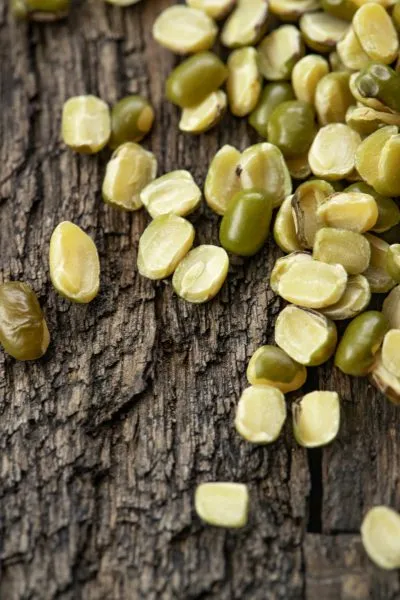
Pulses can often be purchased in four variations, whole, whole with the hull removed, “split” with the hull still attached, or split without the hull. Splitting peas and beans is a convenient way to reduce preparation and cooking time.
| Dal | Lentil or Bean |
|---|---|
| Masoor (Red Lentil) | Lentil |
| Tuvar (Pigeon Pea) | Lentil |
| Moong, Mung | Bean |
| Chana, Chickpea | Bean |
| Urad | Bean |
| Val (Lima Bean) | Bean |
Beans of India
| English Names | Hindi Names | Gujarati Names | Botanical Name | Origin | Other Names | Featured Recipes |
|---|---|---|---|---|---|---|
| Cowpea | Lobia | Chora (dried), Chori (fresh) | Vigna unguiculata | West Africa | Chori, Chawli | Chora nu shaak |
| Hyacinth Bean | Papdi | Papdi, Surti Papdi, Val Papdi | Africa | hyacinth bean,[3] lablab-bean[4] bonavist bean/pea, dolichos bean, seim or sem bean, lablab bean, Egyptian kidney bean, Indian bean, bataw and Australian pea | Papdi nu Shaak Recipe | |
| Green Gram Beans | Moong, Mung | Mug | Vigna radiata | India | Green Bean, Moong, Mash Bean, Munggo, Monggo, Green Gram, Golden Gram | Homestyle Moong Dal in the Instant Pot |
| Black Eyed Peas | Chawli, Lobia | Chora (dried), Chori (fresh) | Vigna unguiculata subsp. unguiculata | West Africa | Chora nu Shaak (Gujarati Style Black-Eyed Peas) | |
| Adzuki | Chawli, Chori | Chora (dried), Chori (fresh) | Vigna angularis | West Africa | Chora nu Shaak (Gujarati Style Black-Eyed Peas) | |
| Moth | Matki | Math | Vigna aconitifolia | India | Dew Beans, Dew Gram, Moth, Mat, Mat Beans, Matki | |
| Red Kidney Beans | Rajma | – | Phaseolus vulgaris | New World (Mesoamerica) | ||
| Soy, soya | Soya | Soya | Glycine max | East Asia | Edamame, Bhat, Bhatwar, Bhetmas, Ramkurthi | |
| Fava, Broad Beans | Baakala | – | Vicia faba | Old World, found in Ancient Israeli sites | Semphalli, Ballor, Bakla | Eromba |
| Lima | Val | Val | Phaseolus lunatus | New World | Bean butter bean, Sieva bean, Double bean, Madagascar bean | Vaal nu Shaak | Lima Beans Curry |
| Runner | sem fhali | – | Phaseolus coccineus | New World | Flat bean, helda bean, romano bean. Butter bean (but don’t confuse with Lima Beans) | |
| Common | – | – | Phaseolus vulgaris | New World. Mesoamerica first, travelled south | Green beans, french beans, string beans | |
| Cluster Bean, Guar | Gawar | Gawar singh | Cyamopsis tetragonoloba | Origins unknown, but probably Africa. Most are grown in India. | gavar, gawar, or guvar bean | |
| Ground / Bambara Beans | Chawli, Lobia | – | Vigna subterranean | West Africa | Congo Goober, Earth Pea, Ground-Bean, Lobiya, Chawli, Chavli, Bambara Groundnut | |
| Yardlong Bean | Chori (fresh) | Chori | Vigna unguiculata subsp. sesquipedalis | West Africa | yardlong bean, pea bean, long-podded cowpea, Chinese long bean, snake bean, bodi, and bora | |
| Velvet Bean | Kiwach, Kaunch ke beej, Baikhujani | Kivanch,Kavatch , Kandchan | Mucuna pruriens | India / Africa / Tropical Asia | Kiwach, Bengal Velvet Bean, Cowage, Cowitch, Lacuna Bean, Monkey tamarind, Bengal velvet bean, Florida velvet bean, Mauritius velvet bean | |
| Black gram | Urad | Adad | Vigna mungo | India | Adad, black lentil, | Dal Makhani (Buttery Black Lentil Curry) |
| Black Chickpea | Desi chana, kala chana | Desi chana, kala chana | Cicer arietinum | Southeast Turkey, cultivated in Middle East | Bengal Gram, Chana, Sanaga Pappu, Shimbra, Chana, Chole | Kala Chana (Black Chickpea) |
| White chickpea | kabuli chana | kabuli chana | Cicer arietinum | Southeast Turkey, cultivate maybe from Afghanistan (named “Kabuli”) | Chana, chole, chickpea, garbanzo bean | Chana Masala (Chole) |
Lentil vs Bean vs Pulse
What is a Pulse?
A pulse is an edible seed from the legume family. It might be a bean, a lentil, or a pea. Plants in the legume family are special because they are nitrogen-fixing, meaning these plants can draw nitrogen out of the air and use it as food.
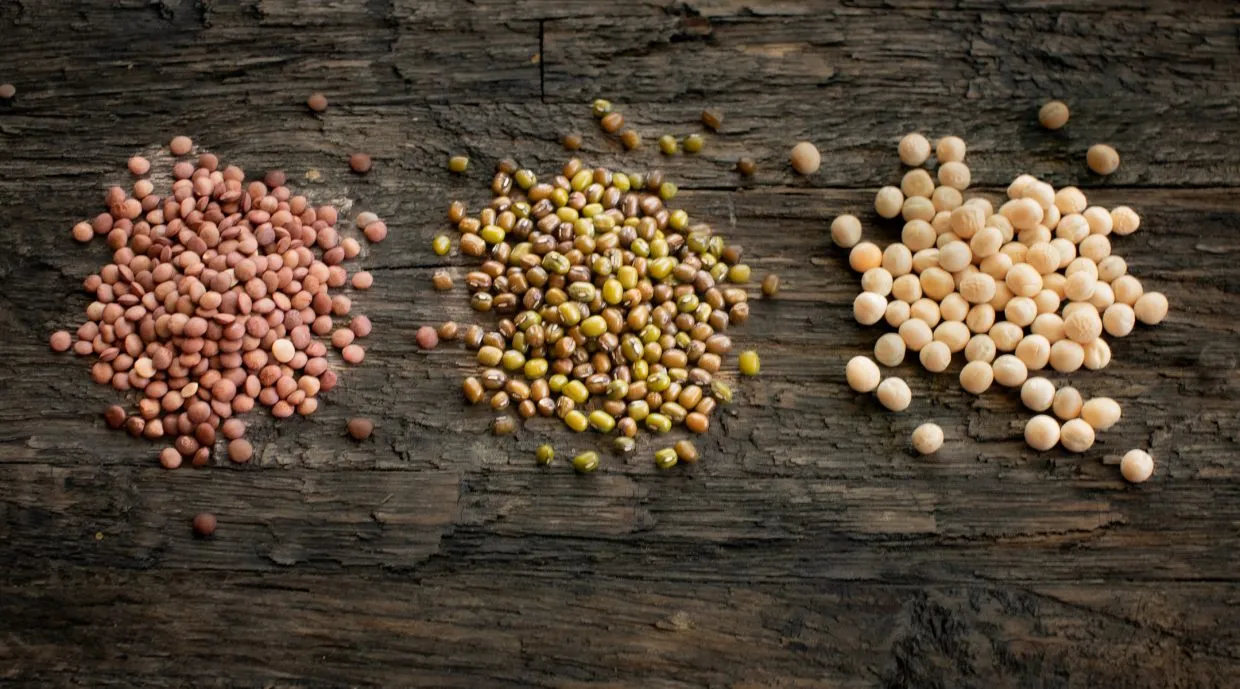
There are thousands of plants in the legume family that can do this, and only a handful of plants that are not legumes that can also do it. They all do it by hosting a soil bacteria called rhizobia that actually does the work.
This is super valuable for two reasons:
- Nitrogen is the main ingredient in fertilizer. Legumes are used by farmers as part of a crop rotation to naturally fertilize the soil for other crops
- Nitrogen is the defining element of protein. That is why lentils and beans are important sources of protein for vegetarians
What is a Lentil?
A lentil is a lens-shaped pulse. In fact, the name lentil means “lens.” Lentils are small and flat. That means they cook quickly and easily compared to beans. For the same reason, lentils do not have to be soaked before they are cooked.
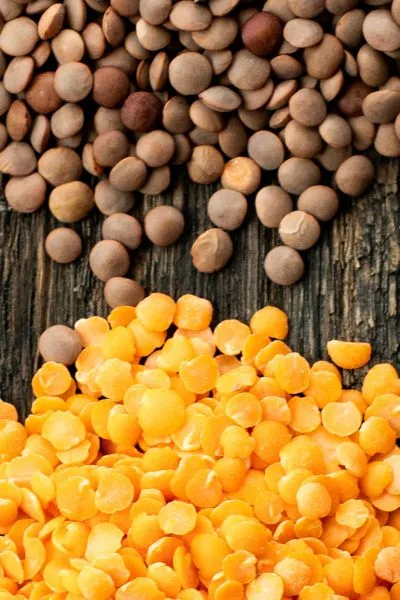
Lentils are all from the same species of plant, but there are many culinary varieties found throughout the world. The most common lentils in Indian cuisine are: toor (tuvar / pigeon pea) and masoor (red lentils). Often people will mistakenly refer to split peas or beans as lentils, but they are not.
What is a Bean?
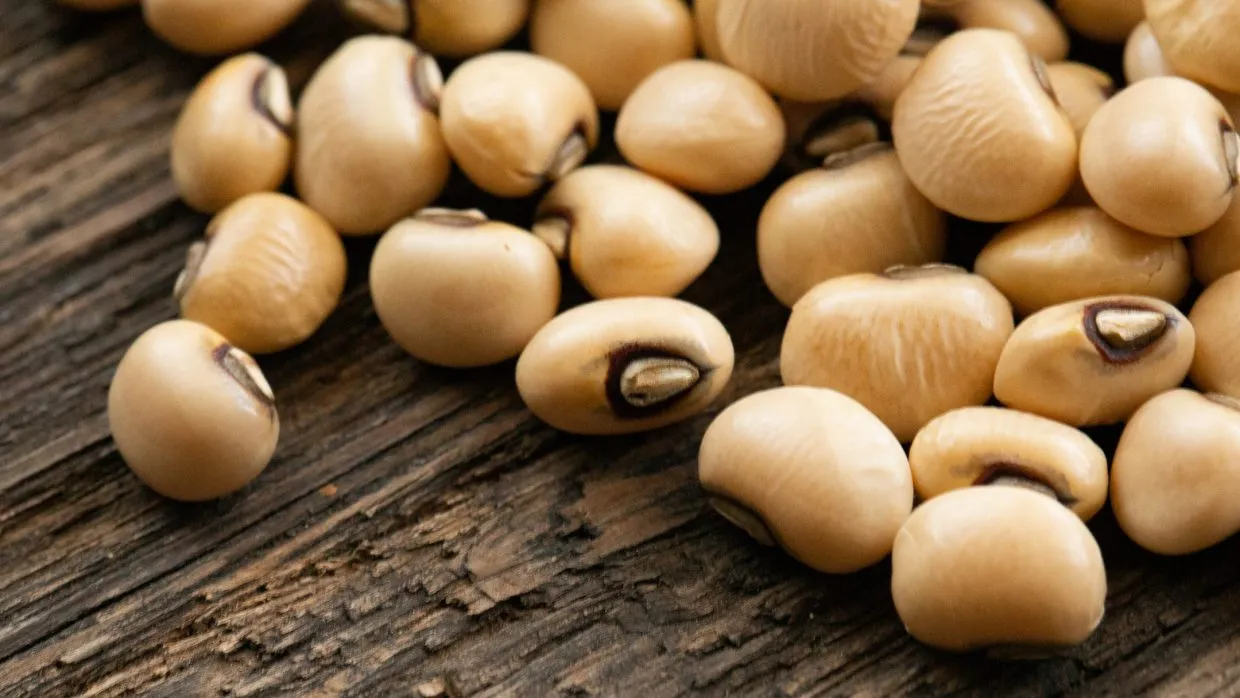
The word “bean” can mean a lot of things depending on the context. Within the world of Indian cuisine, it is safe to say a bean is an edible legume that is typically kidney-shaped and is not a lentil.
Some of the worlds oldest beans are fava beans (broad bean), soybeans, and chickpeas. Chickpeas, or chana, are especially important in Indian cuisine.
Some beans came to India from the New World, like lima beans (val), which is especially important in Gujarati cuisine. Other New World beans include runner beans and common bean.
The term “bean” has also come to be used outside the of the world of legumes for coffee beans, castor beans, vanilla beans, and so on.
Types of Dal, Lentils and Beans
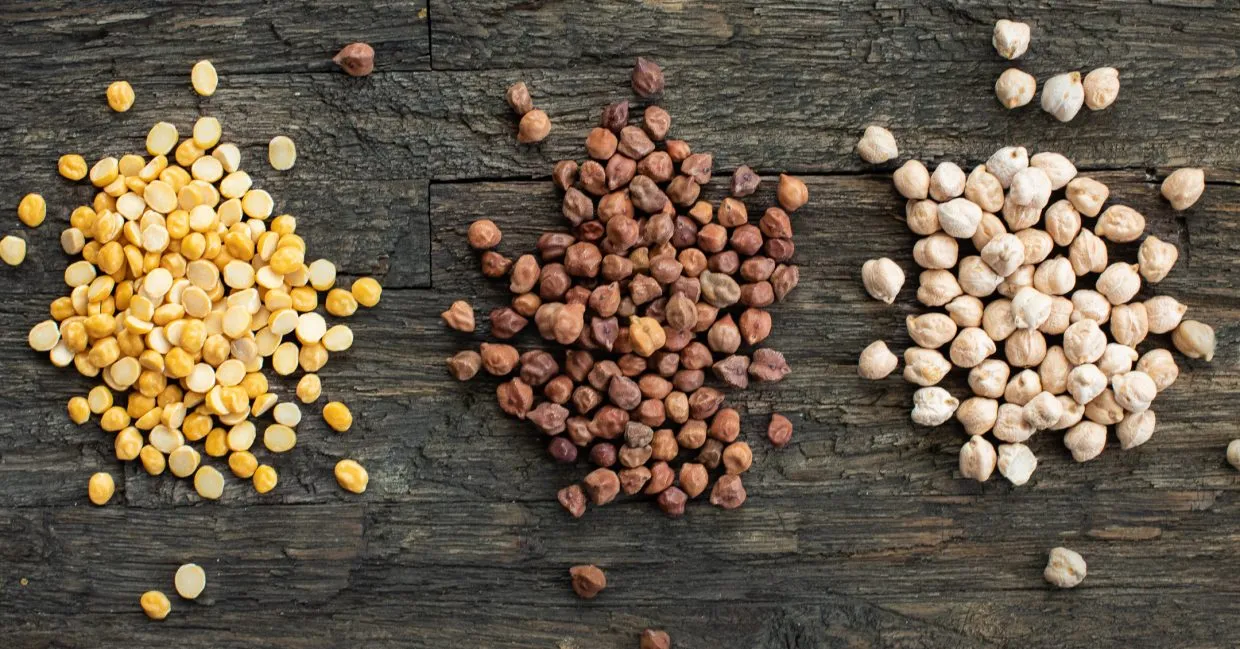
Chana (Chickpea)
Chana (Chickpea)
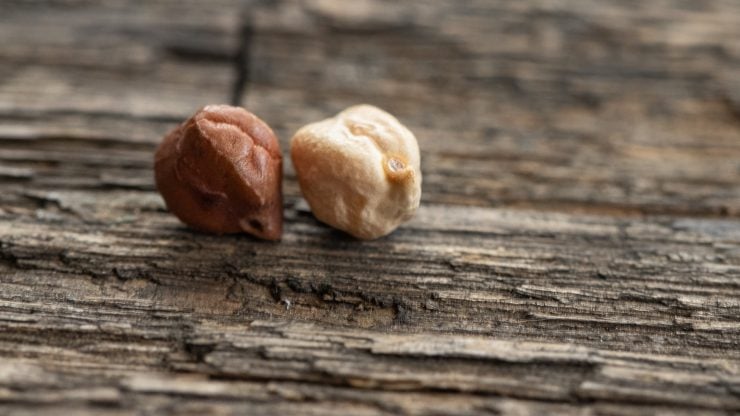
Names
Chana, channa, chickpeas, garbanzo bean, chole
Split Chana
- Soak: optional, 15 minutes
- Boil: 40 minutes
- Instant Pot: 15 minutes
- Pressure Cooker: 15 minutes / 7 whistles
Whole Chana
- Soak: 8 hrs / overnight
- Boil: 80 minutes
- Instant Pot: 20 minutes
- Pressure Cooker: 20 minutes / 8 whistles
Chana, or chickpeas, are found in three dried forms, the smaller dark skinned beans known as desi chana, the larger white skinned beans known as Kabuli chana and the smaller green skinned ones known as hara chana.
Fresh chickpeas are also available at many ethnic markets.
Chana are commonly eaten in India as whole beans, as split lentils, and a multitude of dishes are also made with chickpea flour (known as besan or gram flour).
Chana are slightly nutty in taste. The brown ones are earthier in flavor and tend have a drier texture. Chana Masala is the most popular Indian dish made with Kabuli chana.
Green chana is a bit sweeter than desi chana and Kabuli chana.
Chole, or chana masala, is made with Kabuli chana. Kala chana is a common kathor made with desi chana. Dudhi chana nu shaak is made with chana dal. And many foods are made with besan, like khandvi and pudla.
In addition to a multitude of savory dishes, chana or besan are also used for sweets such as ladoo, magaj, mothanthal and more. Chana dal is often used as the filling for puran poli, a sweet lentil stuffed paratha, although other pulses can be used instead.
Chana Recipes
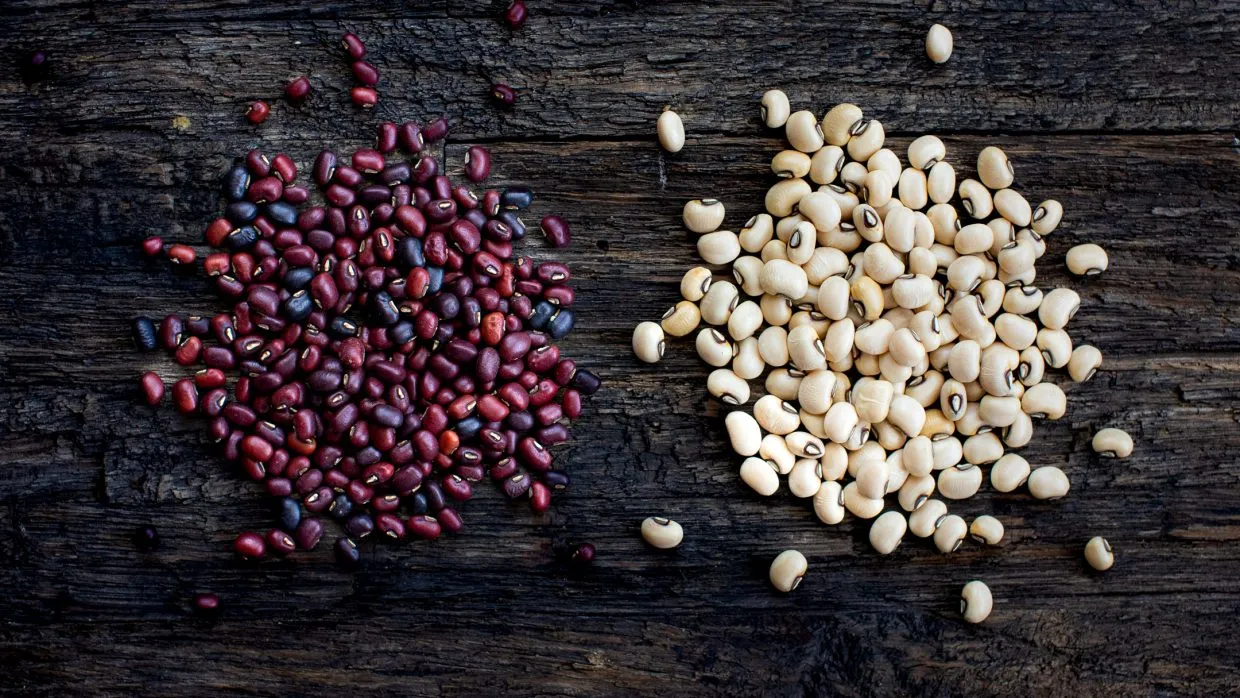

Chawli (Black Eyed Peas)
Chawli (Cowpea)
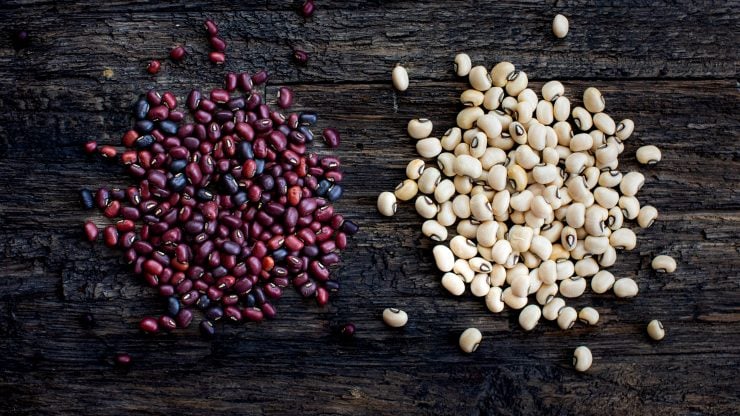

Names
Chawli, lobia, chora, cowpeas, black-eyed peas, adzuki bean, azuki bean, red bean
Split Chawli / Lobia
- Soak: optional, 15 minutes
- Boil: 40 minutes
- Instant Pot: 15 minutes
- Pressure Cooker: 15 minutes / 7 whistles
Whole Chawli / Lobia
- Soak: 8 hrs / overnight
- Boil: 65 minutes
- Instant Pot: 17 minutes
- Pressure Cooker: 17 minutes / 6 whistles
Several kinds of beans are called “chawli” or “cowpeas.” These include two that are very popular throughout the world, including India, Black-eyed peas and Azuki.
Black-eyed pea (also known as cowpea, Hindi: lobia, Gujarati: chora). Black-eyed peas have a distinctive flavor and are an all around pulse in Indian cuisine. They’re used to make curries, dals, papads and fritters.
Adzuki bean (also known as azuki or red cowpea, Hindi: chori, Gujarati: lal chora). Azuki beans have a sweet nutty flavor and are another all around pulse. They are used very much like black-eyed peas.
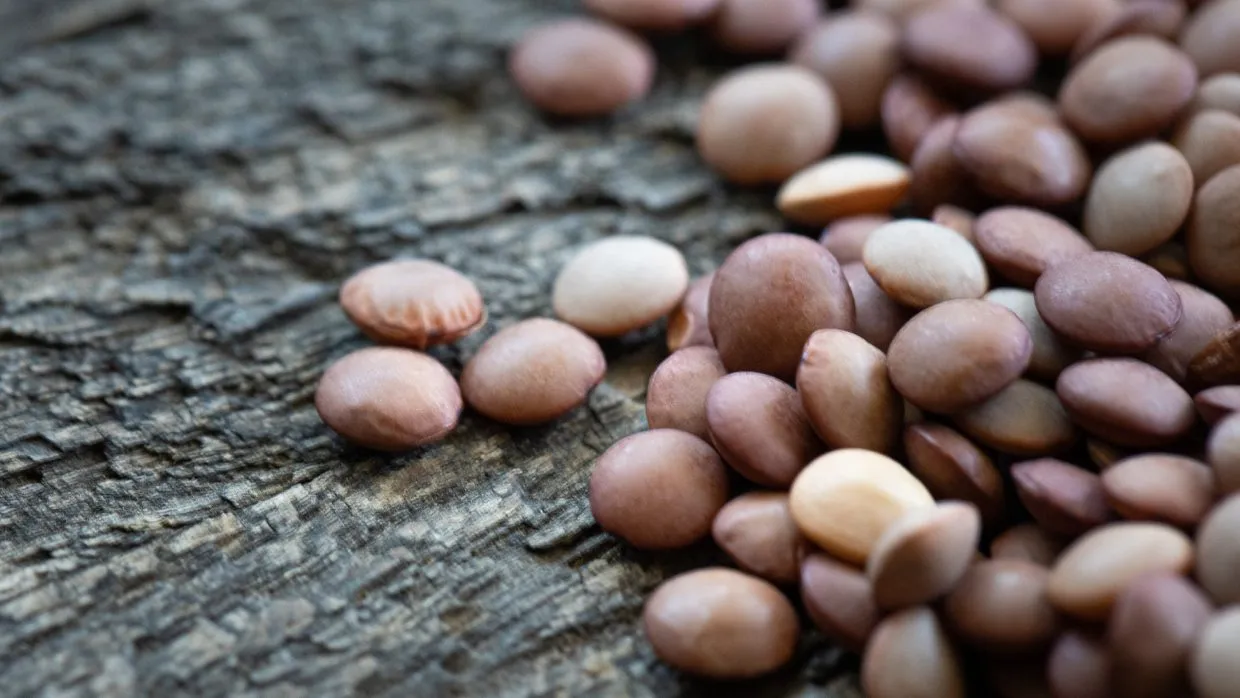

Masoor (Red Lentil)
Masoor (Red Lentil)
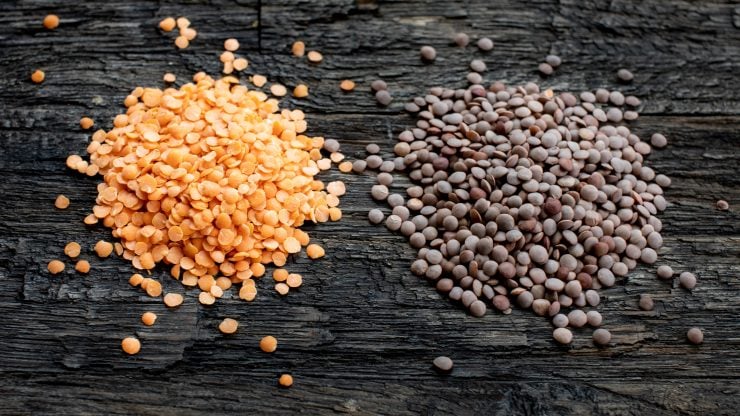

Names
Masoor, masoori, red lentils
Split Masoor
- Soak: Optional, 15 minutes
- Boil: 20 minutes
- Instant Pot: 8 minutes
- Pressure Cooker: 8 minutes / 2 whistles
Whole Masoor
- Soak: Optional, 15 minutes
- Boil: 45 minutes
- Instant Pot: 8 minutes
- Pressure Cooker: 8 minutes / 5 whistles
Masoor (also known as red lentil, Hindi: masoor, Gujarati: masoor) is a brown skinned lentil that is orange on the inside. Masoor dal has a pleasant earthy flavor and is very common in Northern India. It is commonly used to make dal, soups and stews.
Masoor dal cooks very, very fast. You don’t need an Instant Pot or pressure cooker. You can boil it on the stovetop and it will cook up very well, especially if using the split lentil. If you are in a hurry putting a meal together, this is the dal to make.
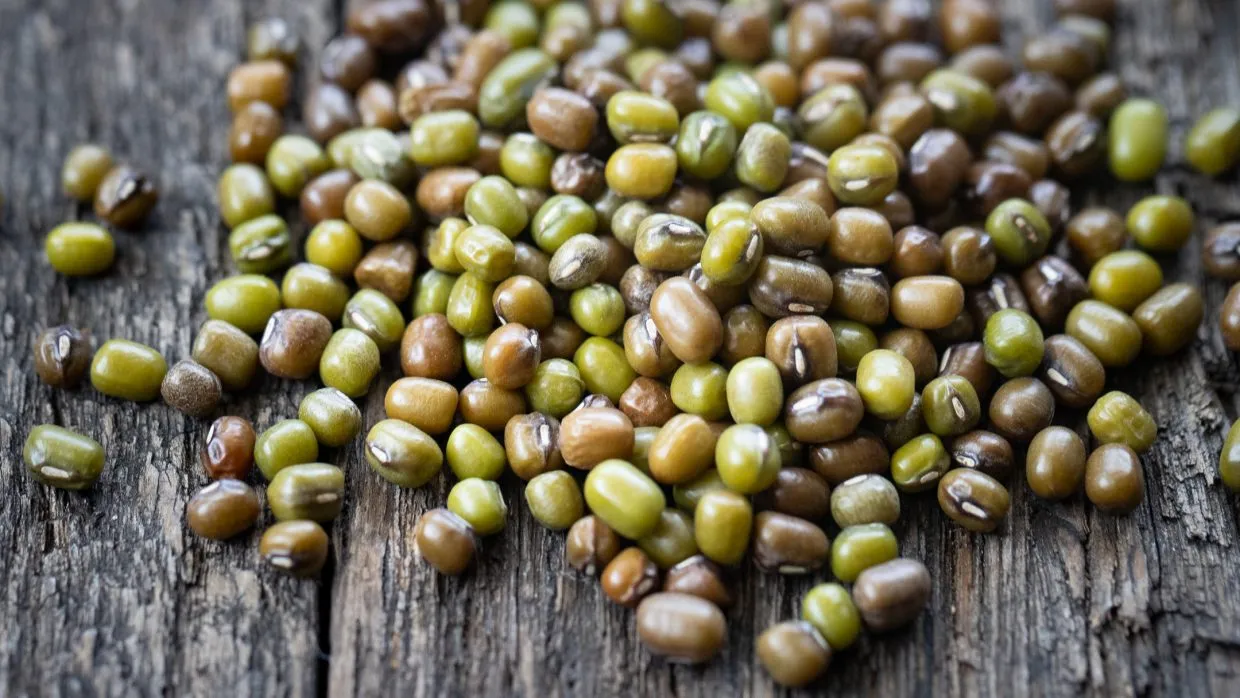

Mung (Moong Bean)
Mung (Moong Bean)
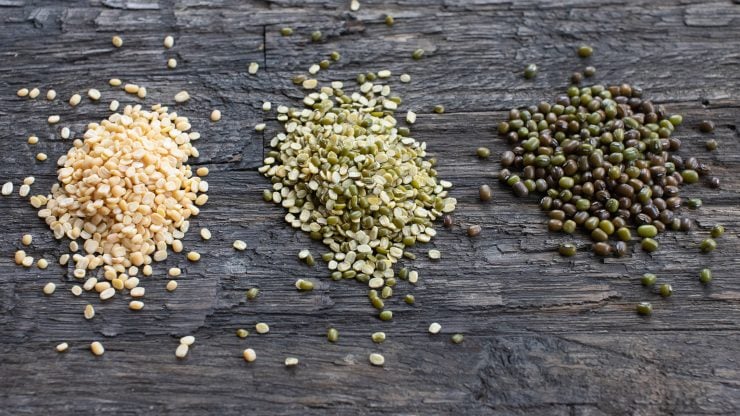

Names
Moong, mung, mug, green gram, maash
Split Mung
- Soak: Optional, 30 minutes
- Boil: 20 minutes
- Instant Pot: 7 minutes
- Pressure Cooker: 7 minutes / 3 whistles
Whole Mung
- Soak: Optional, 4 hours
- Boil: 65 minutes
- Instant Pot: 9 minutes
- Pressure Cooker: 9 minutes / 5 whistles
Mung beans (also known as green gram, Hindi: moong, Gujarati: mug), are little green seeds that are yellow inside. Mung beans have been found in archeological sites, such as Lothal, the oldest known Indus Valley civilization dating back to 2,600 BCE.
Mung beans are used for both sweet and savory dishes in Indian cooking.
They are eaten whole, sprouted, split with the skins on and split with the skins removed. In fact, mung dal (split with the skins removed) is one of the most commonly used lentils in my kitchen.
Mung beans with their skins on have a flavor reminiscent of green leafy vegetables but the mung dal with the skins removed has a mild sweet flavor and is often used for desserts as well as making khichdi and mung dal.
Sprouted moong, often just called “bean sprouts,” are a common ingredient in Indian and Asian cuisines. While they both use moong, Indians do not sprout them for as long.
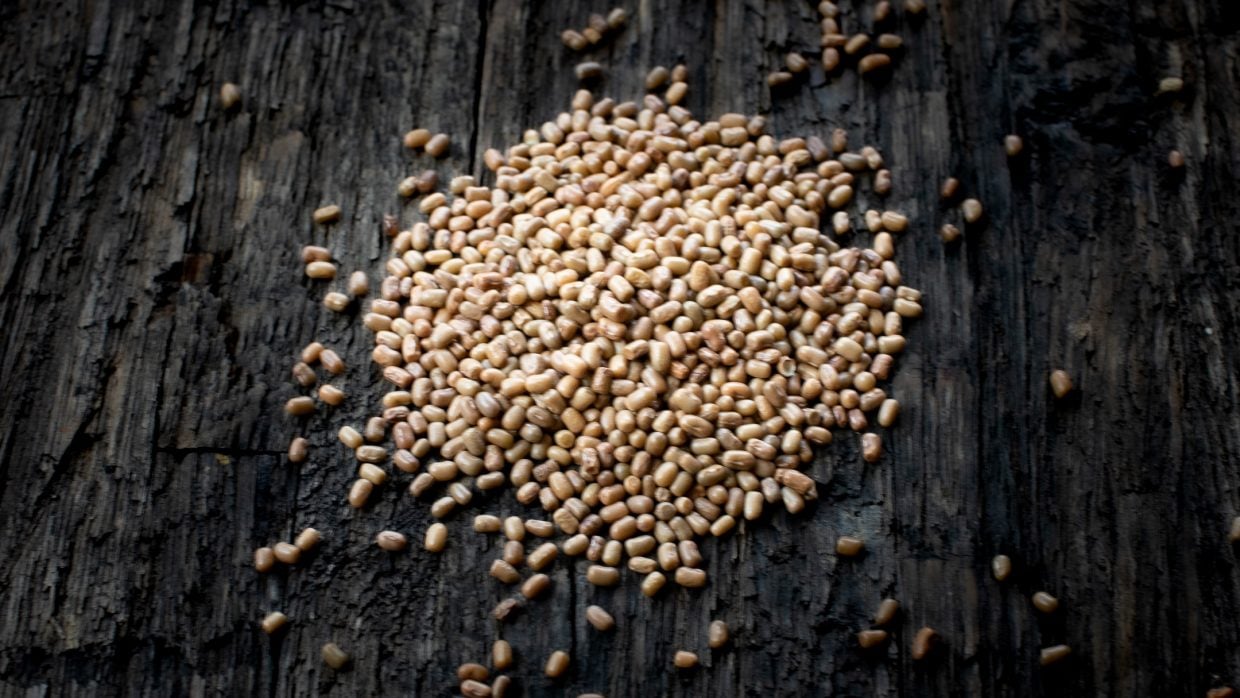

Math (Moth) Bean
Math (Moth) Beans


Names
Moth, math, mat bean, moth bean, matki, dew bean
Split Moth
- Soak: Optional, 15 minutes
- Boil: 45 minutes
- Instant Pot: 8 minutes
- Pressure Cooker: 8 minutes / 5 whistles
Whole Moth
- Soak: 8 hours or overnight
- Boil: 90 minutes
- Instant Pot: 12 minutes
- Pressure Cooker: 12 minutes / 6 whistles
Moth beans, known as math in Gujarati, are also known as mat bean, moth bean, matki or dew bean. Moth beans are common throughout India. They are valued as a crop because they are fast growing and very drought tolerant.
My favorite thing to do with them is to sprout them, similar to mung beans. I prefer moth beans for this because they are more earthy but without the grassiness of mung bean sprouts.
Some of my favorite foods with moth beans are math dal, a Gujarati dish, math nu shaak, spinach and lal math, and the street food, misal pav.
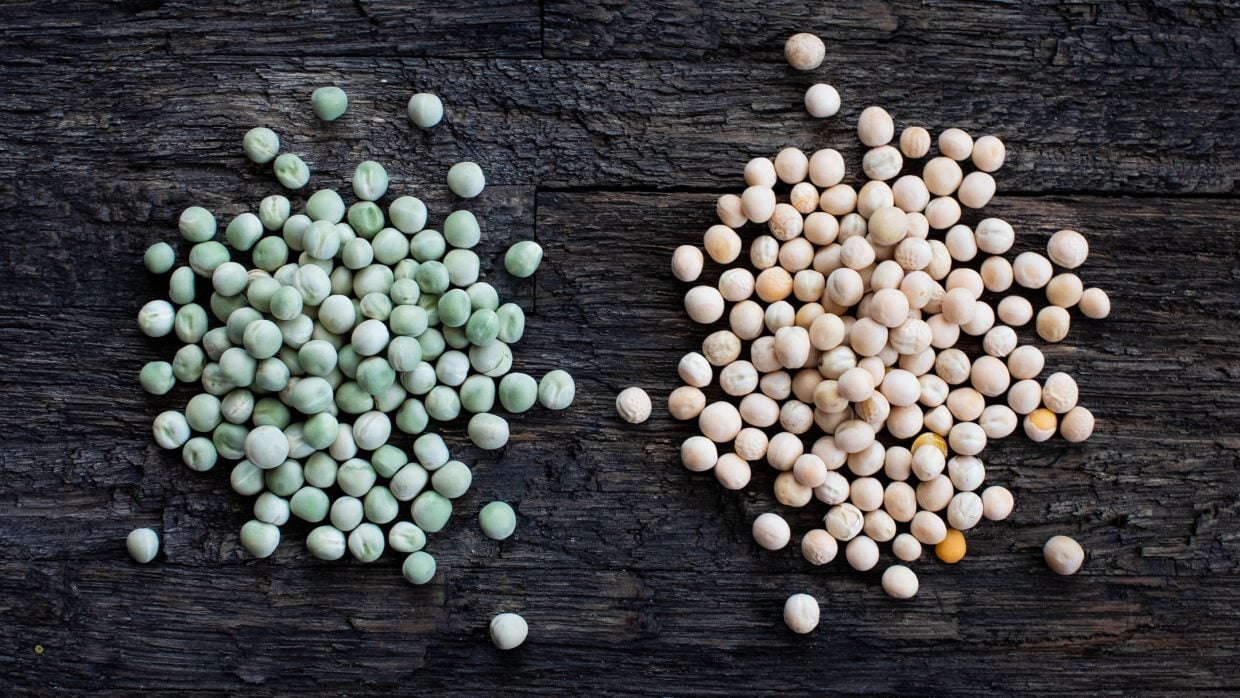

Matar (Peas)
Matar
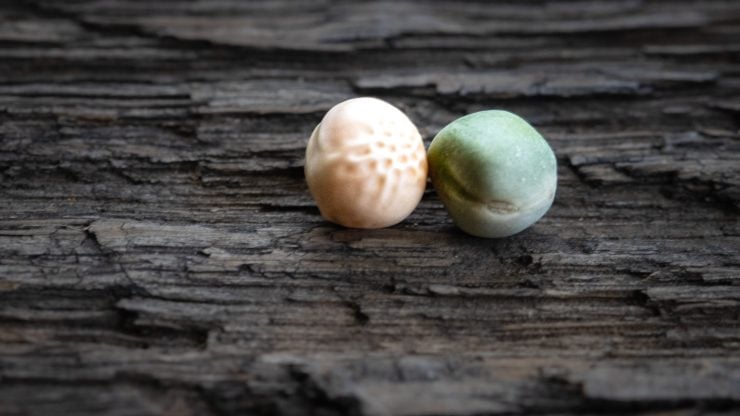

Names
Matar, vatana, pea
Split Matar
- Soak: Optional, 30 minutes
- Boil: 35 minutes
- Instant Pot: 8 minutes
- Pressure Cooker: 8 minutes / 5 whistles
Whole Matar
- Soak: 8 hours or overnight
- Boil: 80 minutes
- Instant Pot: 20 minutes
- Pressure Cooker: 20 minutes / 8 whistles
Peas are another kind of legume, they are all from the plant species Pisum sativum and include green peas, yellow peas, snap peas, snow peas, English peas and more.
They are round and wrinkly and grow in pods. Some beans also use the pea name, like chickpeas and black-eyed peas, but are not true peas.
In Indian food, we often treat them as either beans or lentils, depending on the dish. Fresh peas are added to many dishes for added nutrition and color, such as pulao and upma.
Matar paneer is a common restaurant dish made much like paneer makhani, but with peas added to the sauce. Methi malai matar is another popular dish made with cream, peas and fenugreek.
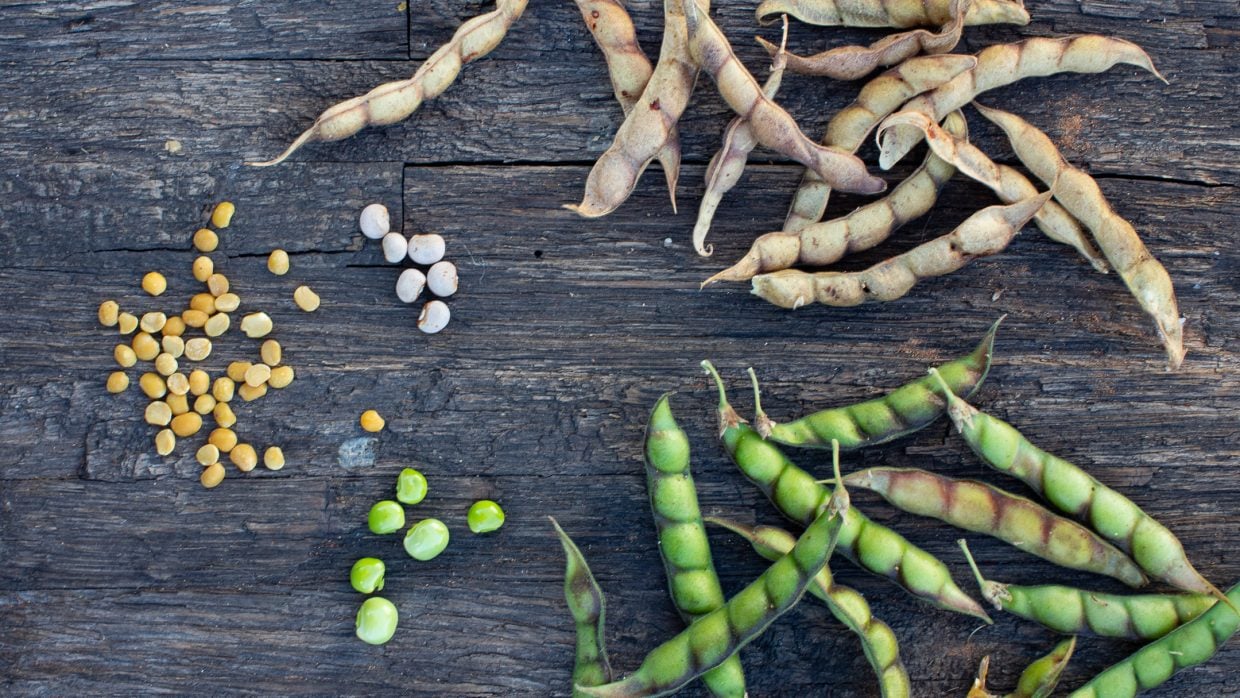

Toor (Tuvar or Pigeon Pea)
Toor
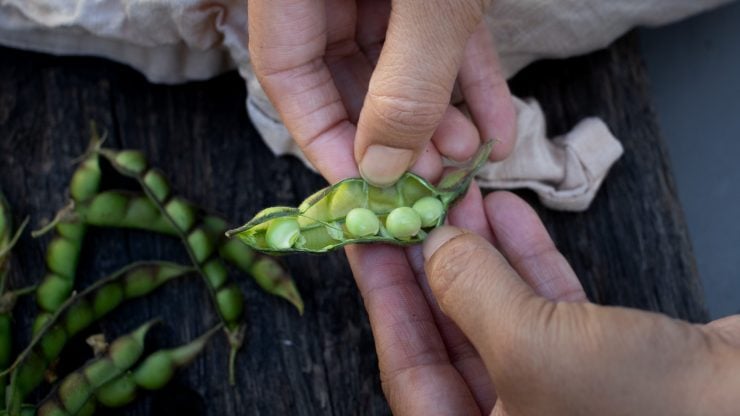

Names
Toor, tuvar, tuver, pigeon pea
Split Toor
- Soak: Optional, 30 minutes
- Boil: 35 minutes
- Instant Pot: 8 minutes
- Pressure Cooker: 8 minutes / 5 whistles
Whole Pea
- Soak: 8 hours or overnight
- Boil: 80 minutes
- Instant Pot: 18 minutes
- Pressure Cooker: 18 minutes / 8 whistles
Pigeon Pea (also known as tropical green pea, Hindi: toor, Gujarati: tuvar or tuver), is a beige lentil with a yellow interior.
Tuvar is the most important pulse in a Gujarati household. The fresh peas are highly prized and used for curries and stuffing in spicy handpies.
Toor has a delicious nutty flavor that is very distinctive. The dried and split peas are a staple in everyday cooking as well. They have a courser texture and compared to other dals like mung, they are not creamy.
The famous “Gujarati Dal” is made with this pea where the balance between spicy, sweet and sour is most important. It is also used in curries and spicy handpies (kachori, savory ghooghras).
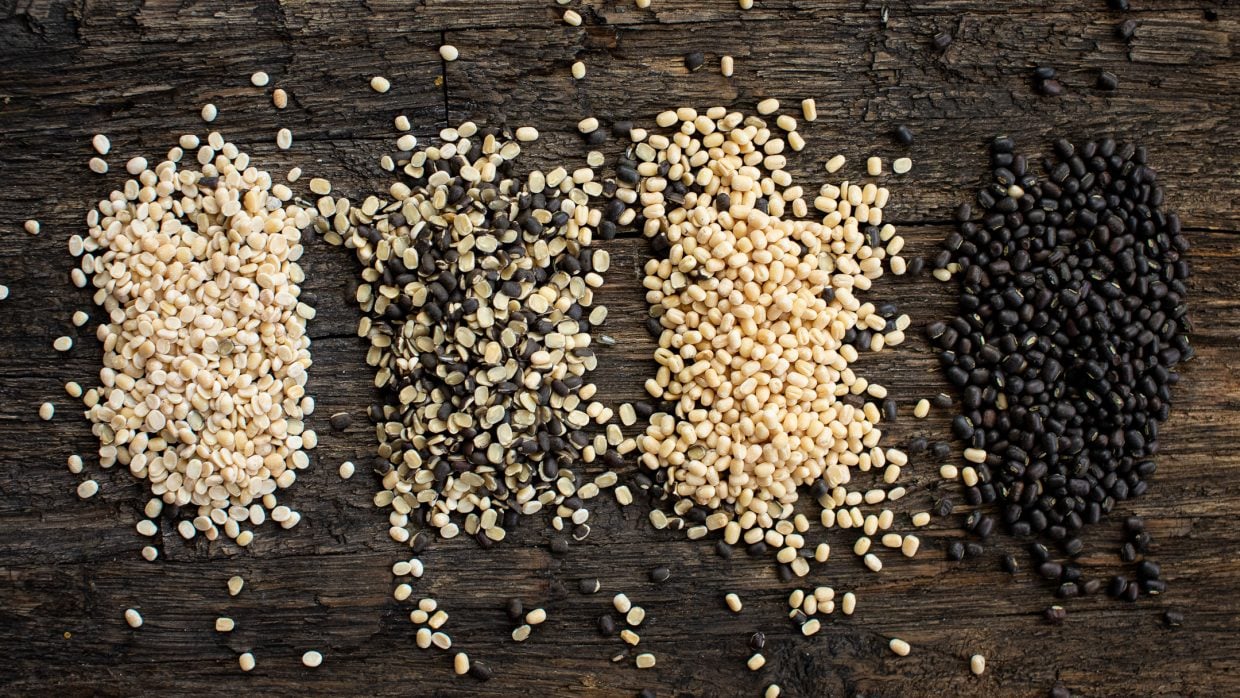

Urad (Black Lentil)
Urad
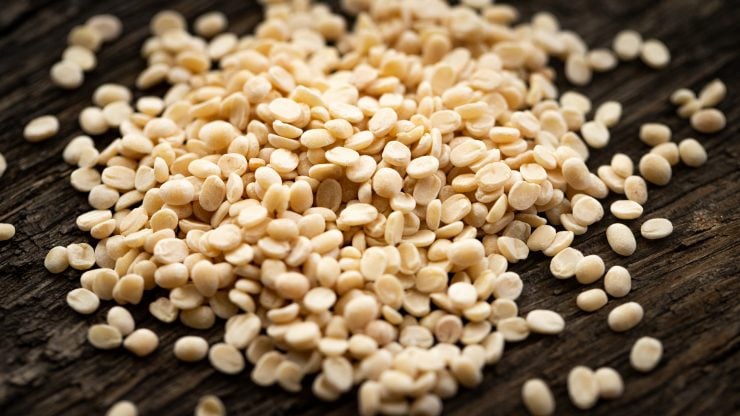

Names
Black gram, black lentil, urad (Hindi), adad (Gujarati)
Split Urad
- Soak: Optional, 30 minutes
- Stovetop: 30 minutes
- Instant Pot: 8 minutes
- Pressure Cooker: 8 minutes / 4 whistles
Whole Urad
- Soak: 4 hours or overnight
- Stovetop: 65 minutes
- Instant Pot: 11 minutes
- Pressure Cooker: 11 minutes / 6 whistles
Urad (also known as black gram, black lentil, Hindi: urad, Gujarati: adad), is a little black seed with a white interior.
Urad is very similar to a mung bean in size and shape but tastes entirely different. It has also been eaten in India for thousands of years and is highly prized.
Urad has an earthy flavor and an unusual mucilaginous texture (it’s a good thing!) when cooked. The popular dal makhani, a dark, buttery lentil dish, is made with urad.
Poppadam, or papad, is typically made with urad. Urad dal is also often mixed with rice for fermented batter recipes such as dosa and idli.


Val (Lima Bean)
Val
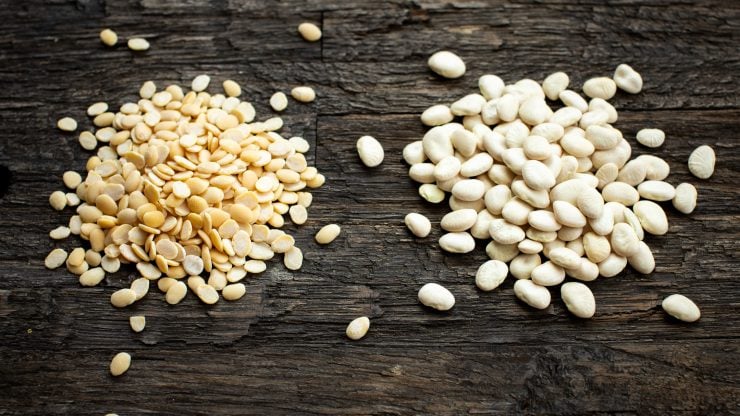

Names
Val, double bean, lima bean, butter bean, Madagascar bean, wax bean
Split Val
- Soak: Optional, 30 minutes
- Stovetop: 20 minutes
- Instant Pot: 8 minutes
- Pressure Cooker: 8 minutes / 4 whistles
Whole Val
- Soak: 8 hours or overnight
- Stovetop: 60 minutes
- Instant Pot: 14 minutes
- Pressure Cooker: 14 minutes / 8 whistles
Val are a New World bean, yet are one of the most beloved beans in Gujarat, often served at weddings and other special occasions.
Gujaratis cook them with lots of garlic and ajmo (carom seeds). They have a strong flavor.
They originated in Peru and were domesticated about 4,000 years ago. They made it to India by way of the Portuguese. Val is popular throughout the world, especially in Mexico, the American South, Spain, and India.
Like kidney beans, lima beans are toxic unless boiled for at least 10 minutes. A pressure cooker will work as well, but a slow cooker will amplify this toxicity if not boiled out first.
How to Cook Indian Lentils and Beans
| Bean | Stove Top Cook Time | Pressure Cooker or Instant Pot Time | Pressure Cooker Whistles | Slow Cooker Time | Soak Time |
|---|---|---|---|---|---|
| Mung, whole | 65 minutes | 9 minutes | 5 | low: 5 hours | 4 hours (optional) |
| Mung, split with skin | 20 minutes | 7 minutes | 3 | low: 4 hours | 30 minutes (optional) |
| Mung, split | 20 minutes | 7 minutes | 3 | low: 4 hours | 30 minutes (optional) |
| Urad, whole | 65 minutes | 11 minutes | 6 | low: 6 hours | 4 hours (optional) |
| Urad, split with skin | 30 minutes | 8 minutes | 4 | low: 4 hours | 30 minutes (optional) |
| Urad, split | 30 minutes | 8 minutes | 4 | low: 4 hours | 30 minutes (optional) |
| Garbanzo, brown | 80 minutes | 20 minutes | 8 | low: 8 hours | 8 hours to overnight |
| Garbanzo, white | 80 minutes | 20 minutes | 8 | low: 8 hours | 8 hours to overnight |
| Garbanzo, split (chana dal) | 40 minutes | 15 minutes | 7 | low: 7 hours | optional |
| Masoor, whole | 45 minutes | 8 minutes | 5 | low: 7 hours | optional |
| Pigeon Pea, whole | 80 minutes | 18 minutes | 8 | low: 8 hours | 8 hours to overnight |
| Pigeon Pea, split (tuver dal) | 35 minutes | 8 minutes | 5 | low: 5 hours | 30 minutes (optional) |
| Black-eyed Pea, whole | 65 minutes | 18 minutes | 6 | low: 7 hours | optional |
| Black-eyed Pea, split | 35 minutes | 9 minutes | 4 | low: 4 hours | optional |
| Adzuki, whole | 65 minutes | 17 minutes | 6 | low: 7 hours | optional |
| Pea, whole | 65 minutes | 16 minutes | 6 | low: 7 hours | 8 hours to overnight |
| Kidney Beans, whole | Boil for 30 minutes then simmer for 30 to 60 more minutes. | 14 minutes | 6 | Toxic. Do not cook in slow cooker. | 8 hours to overnight |
Cooking Notes:
Before you cook pulses, always sift through them to take out any pebbles or debris. Then rinse them a few times.
Pulses taste best when they are cooked slowly. When cooking pulses on the stove top, bring to a boil and lower heat to medium low and let simmer.
Start counting the cooking time once the pot has come to a boil and not before. In the case of kidney beans, boil for 30 minutes before lowering heat to simmer.
If your pulses are old, they can take double the time to cook. If they haven’t softened in the time indicated, don’t worry. Just cook until soft. Make sure to add more water as needed.
When cooking pulses, hold off adding salt or acids (such as lemon or vinegar) until the end, or the they will not soften.
How Much Water to Use
If you are cooking on the stovetop or slow cooker, use about 3 to 4 times the amount of water as you have pulses. In the Instant Pot or pressure cooker, two times the water will do. Always keep an eye on the stove and add more water if it starts to look dry.
Indian pressure cookers are a little different from the ones available in the West. They usually release steam regularly in what is referred to as “whistles.”
These whistles are counted to determine cook time. They are not always accurate and can vary from cooker to cooker. Use these whistle counts as a guide and figure out what works best for your cooker.
Soaking Lentils
In the cases where soaking is optional, if you soak the pulses, it will reduce the cooking time. The cooking time I’ve mentioned is for unsoaked pulses where soaking is optional and for soaked pulses where soaking is recommended before cooking.
Slow cookers can be a great, convenient way to prepare pulses, just throw everything in in the morning and when you get home from work your food is ready.
Some beans, e.g. kidney beans, are toxic until they are boiled (for at least 30 minutes), and slow cookers can make them more toxic! If you want to use the slow cooker on these beans, boil them for 30 minutes before adding them to the mixture, or use canned beans.
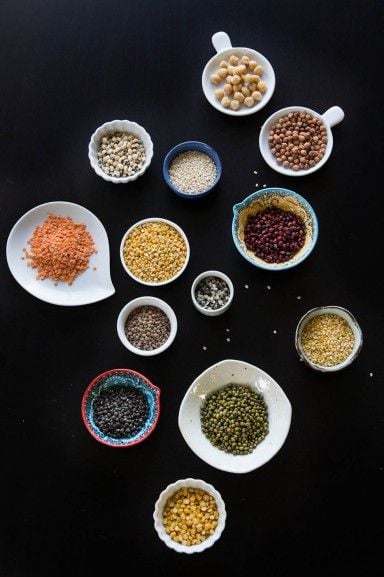

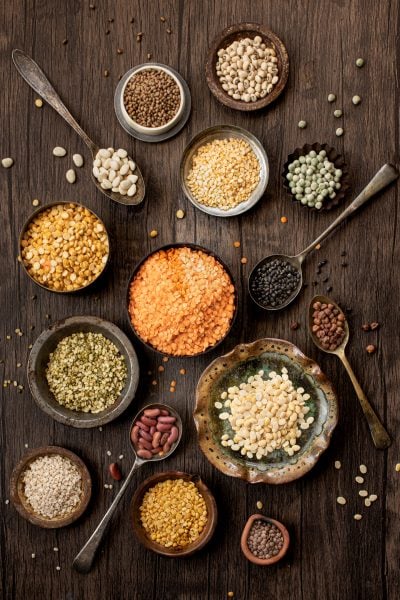

(Originally published January 23, 2014; republished with major updates September 7, 2022)

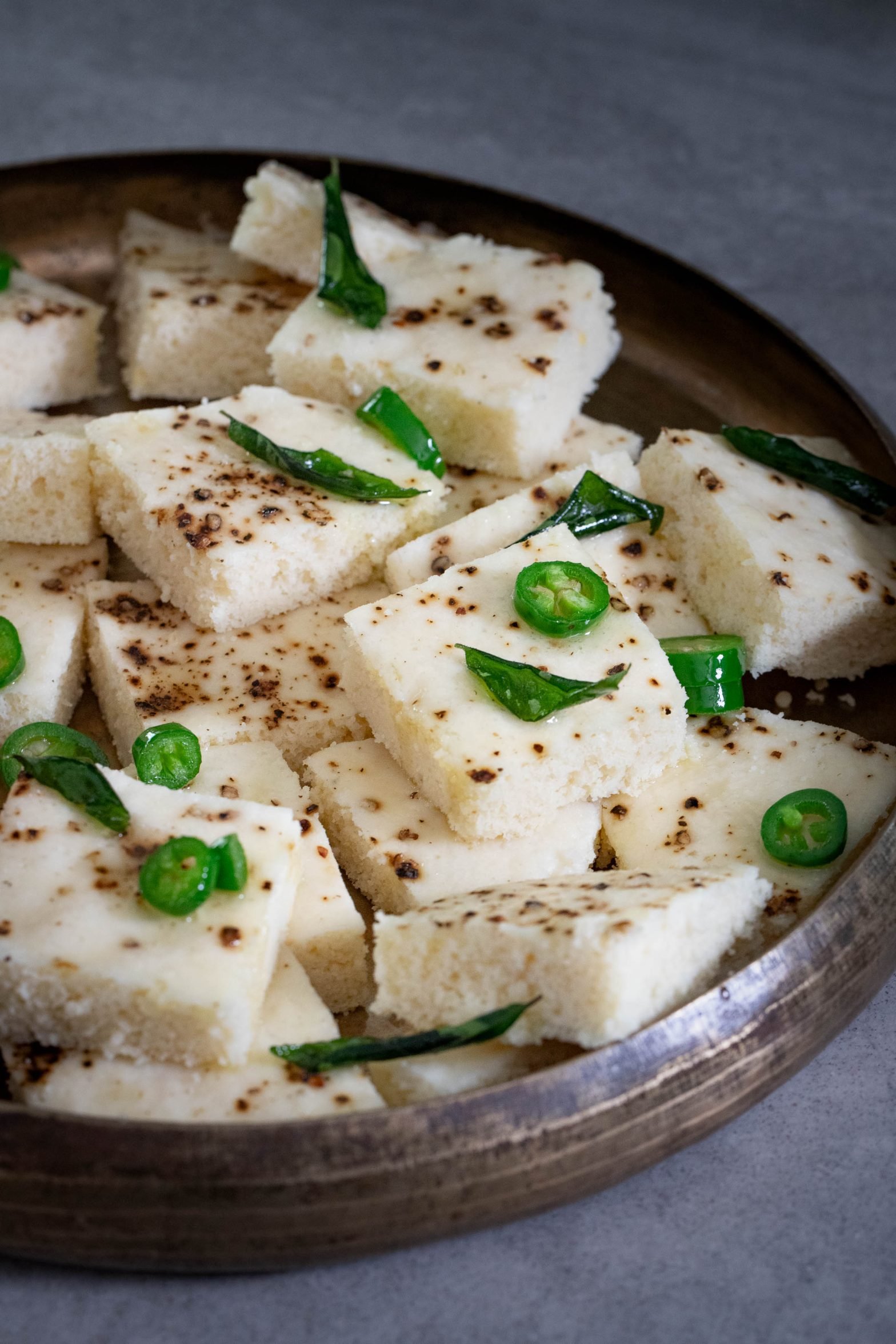
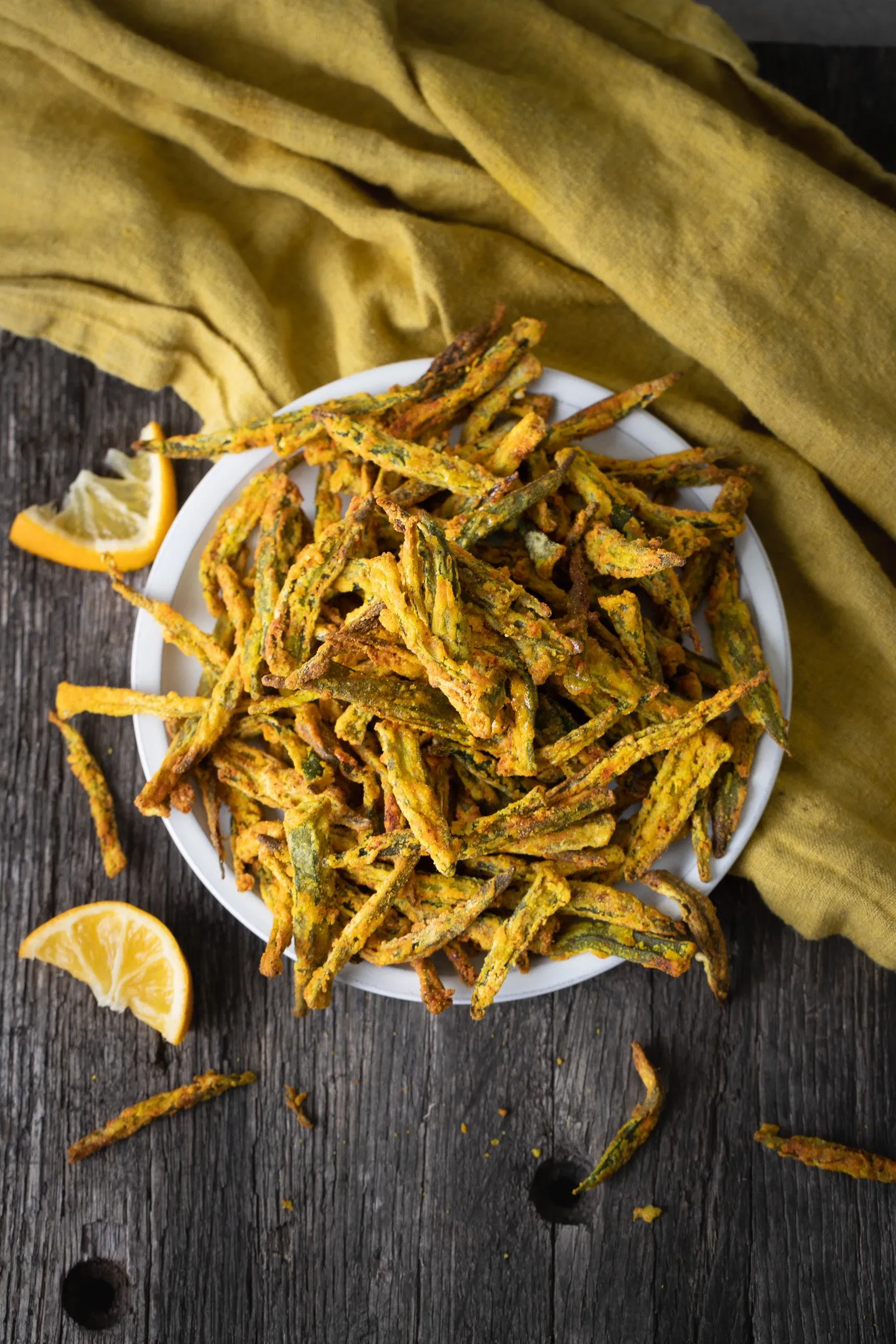
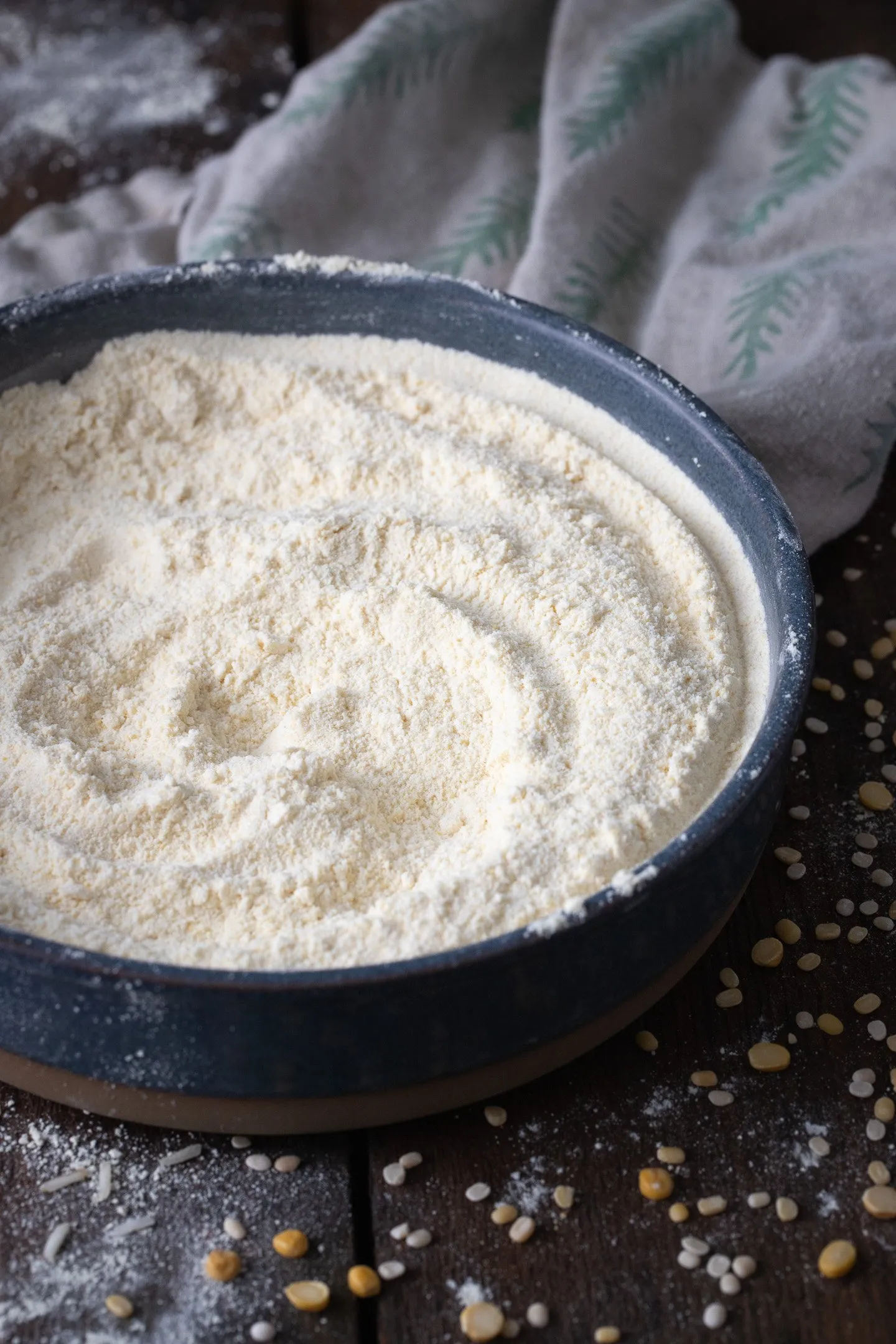
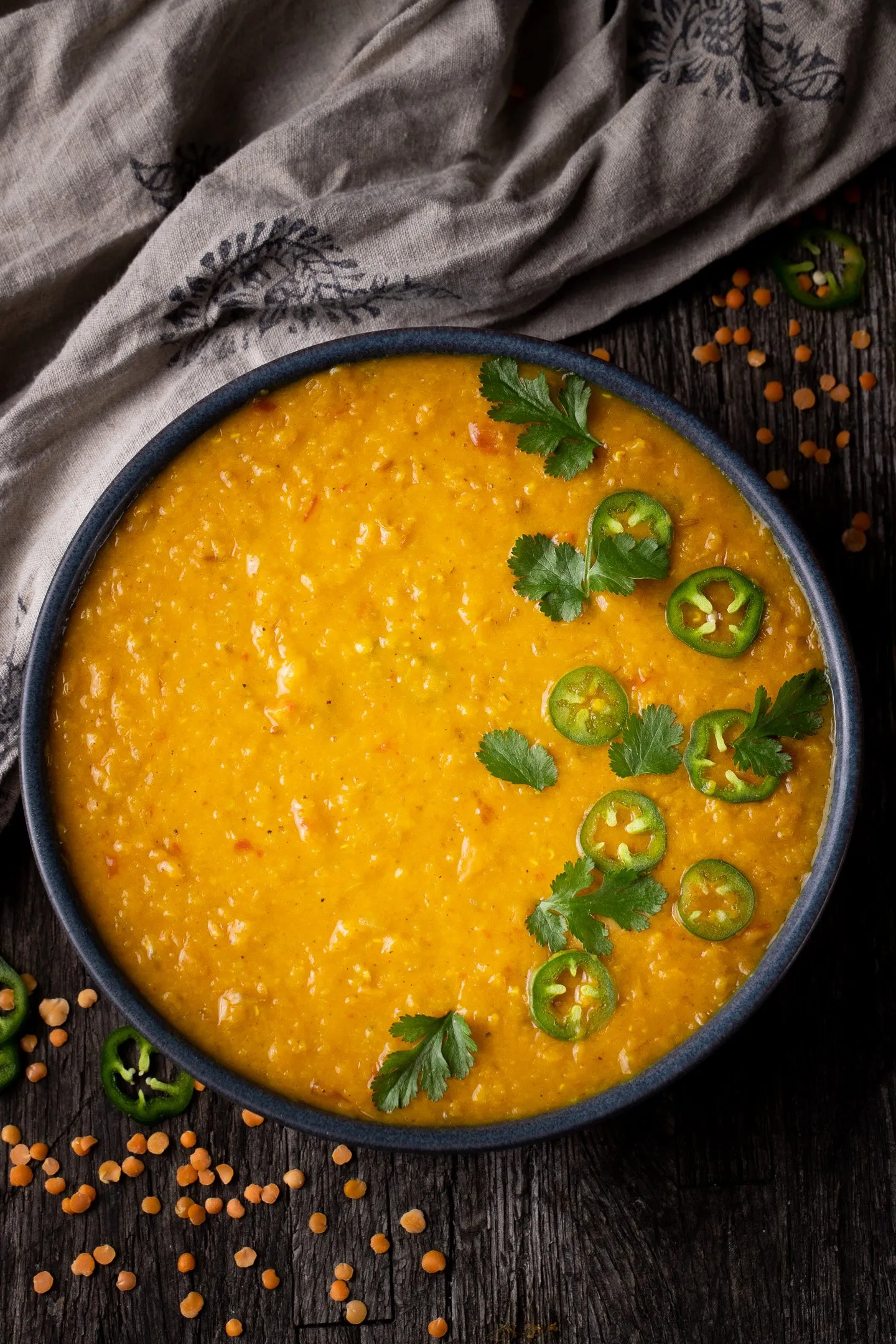
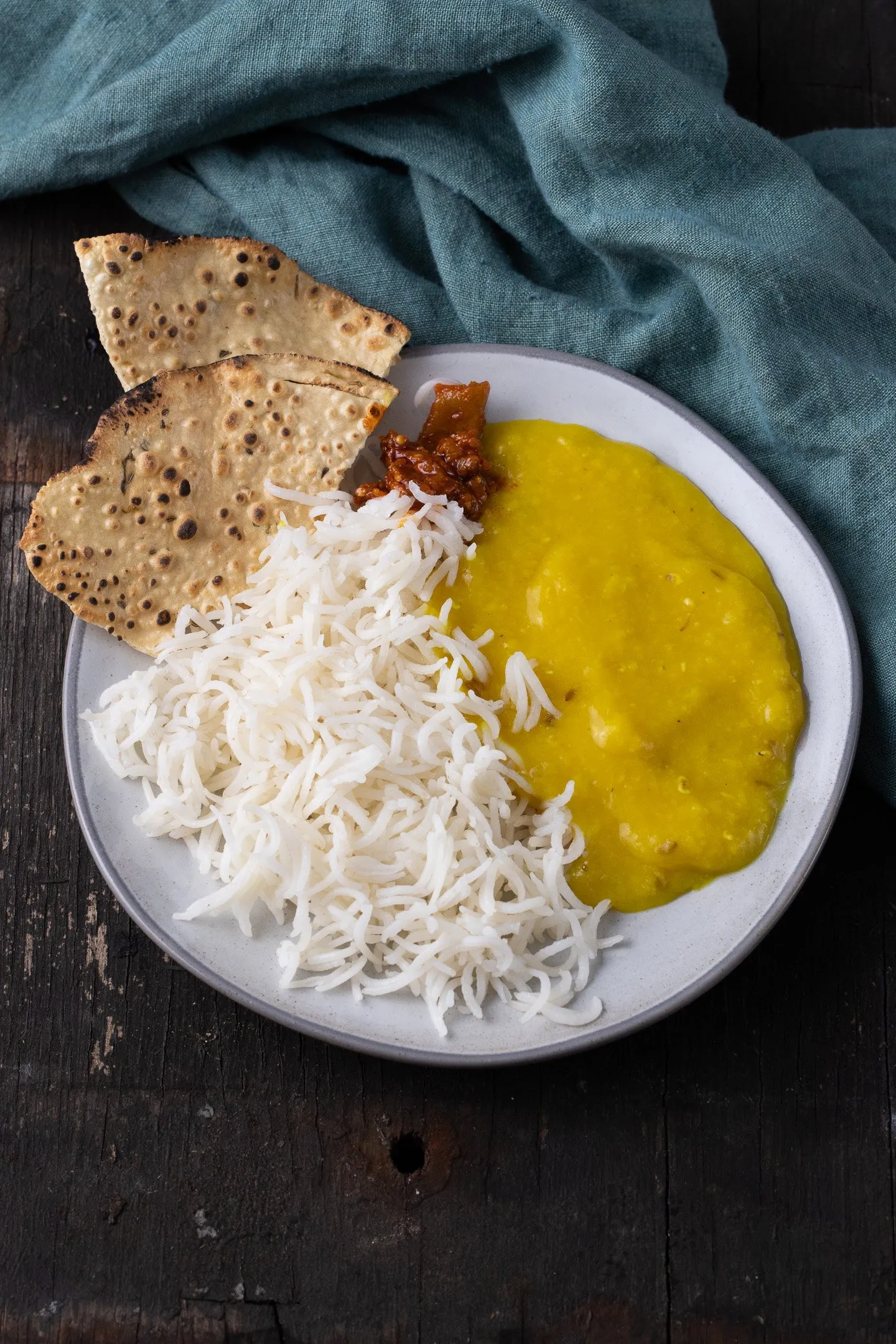
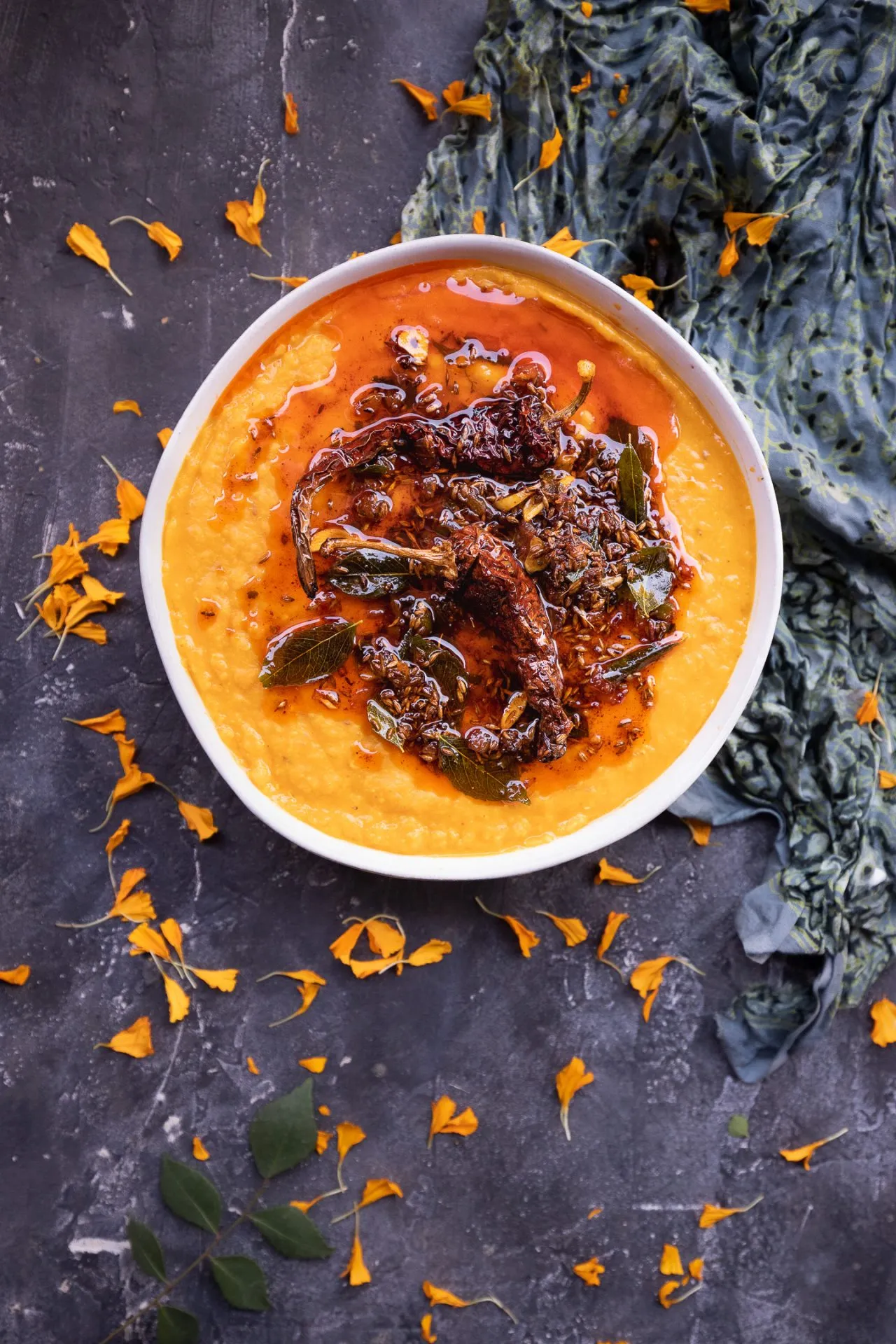
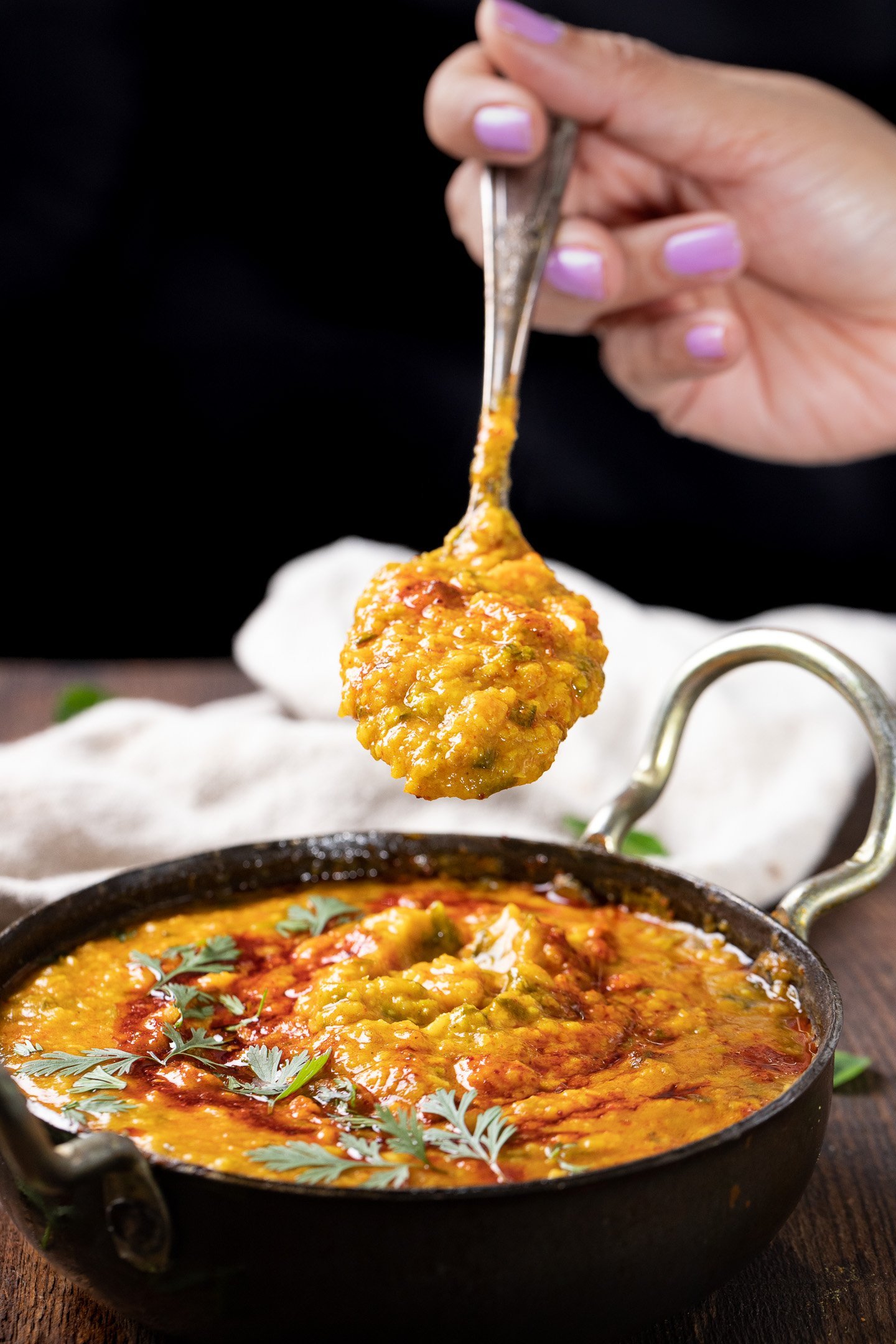
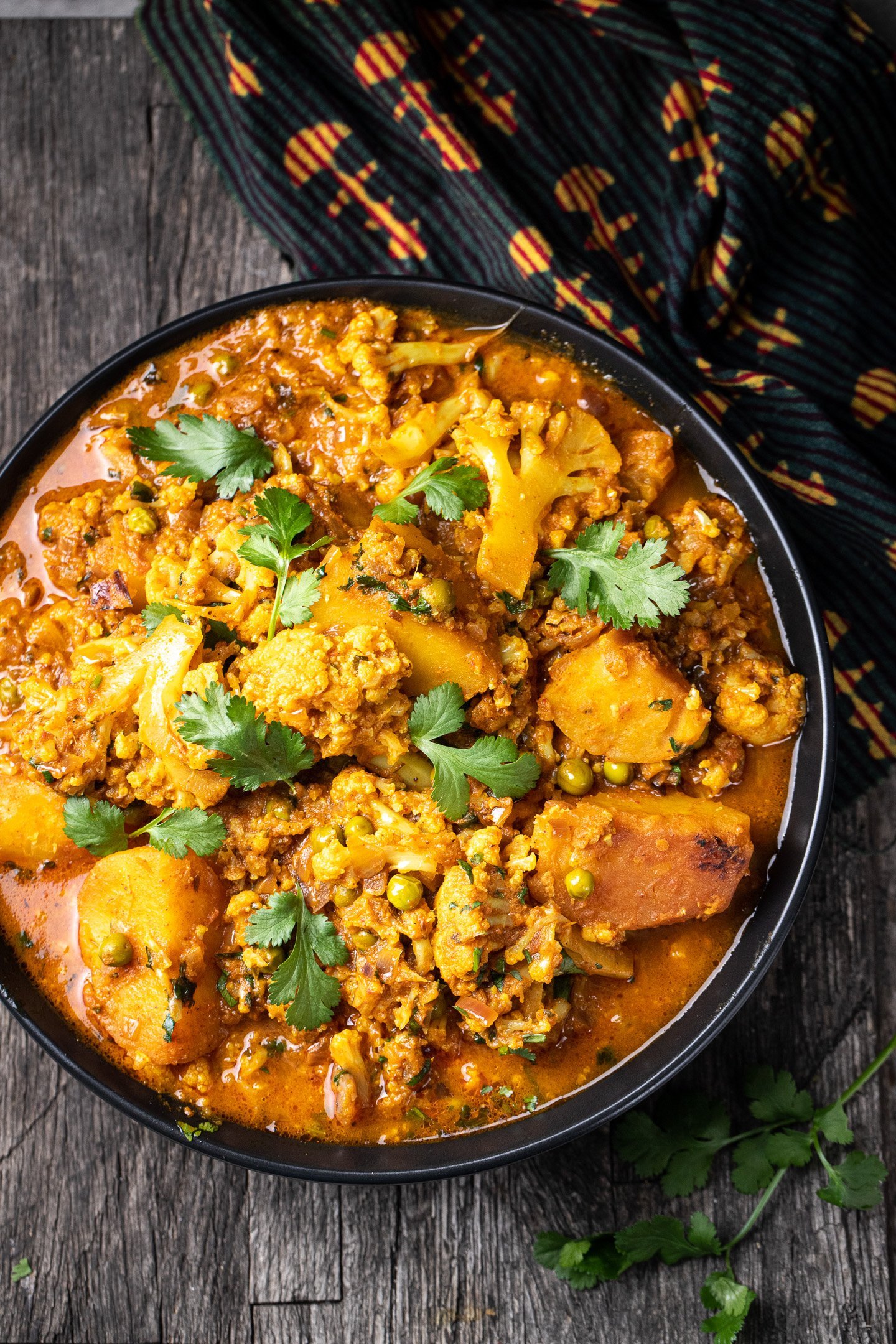

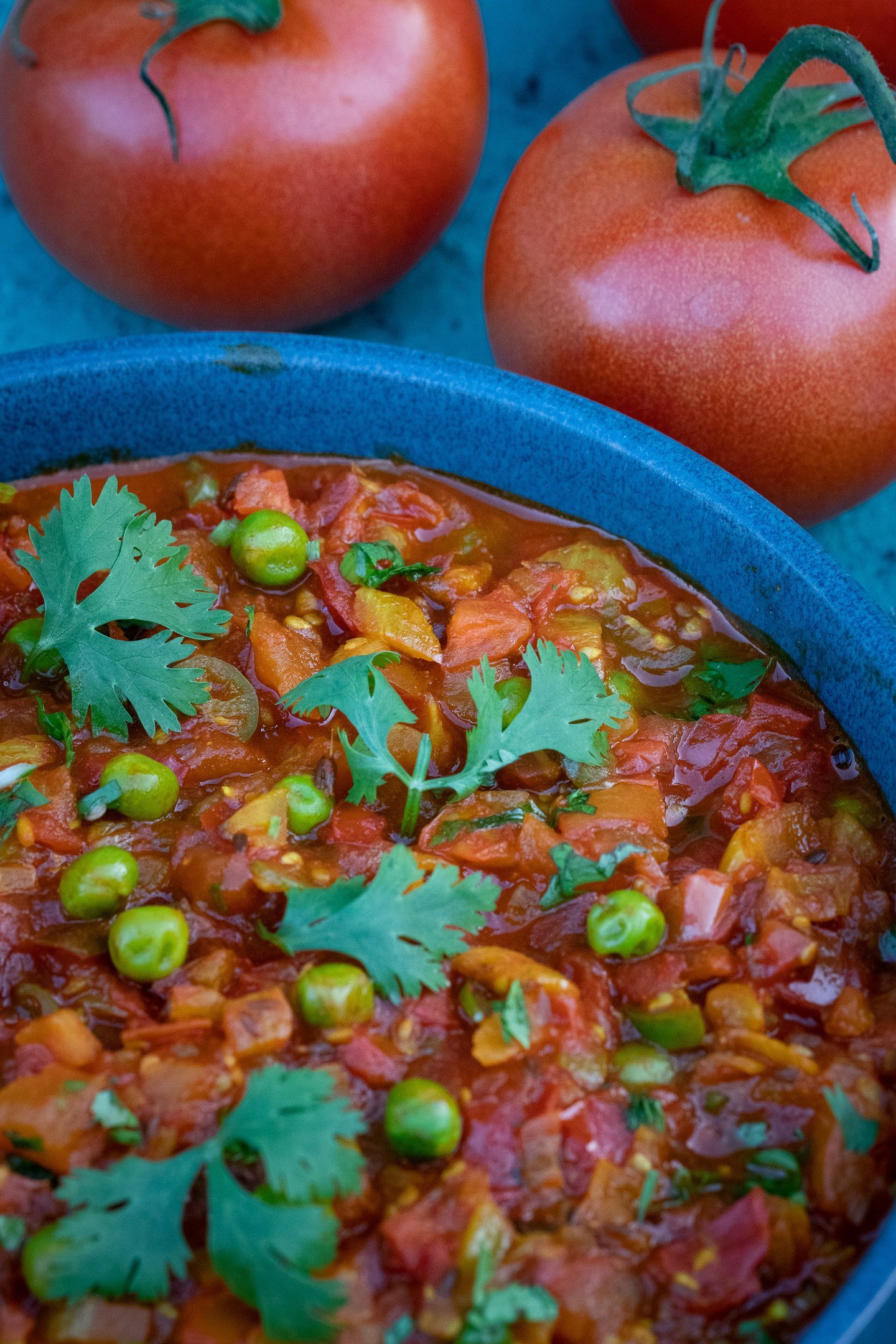

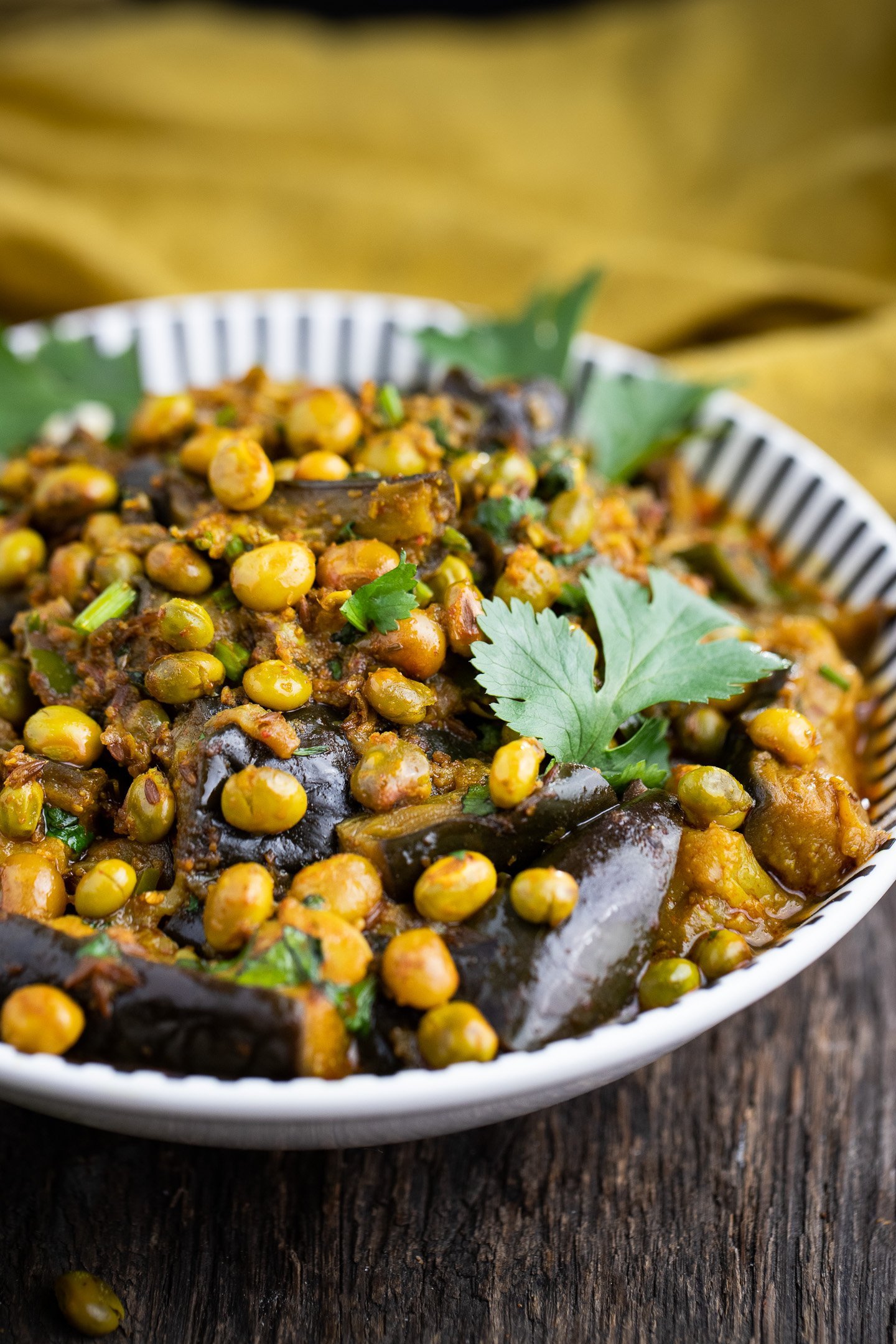
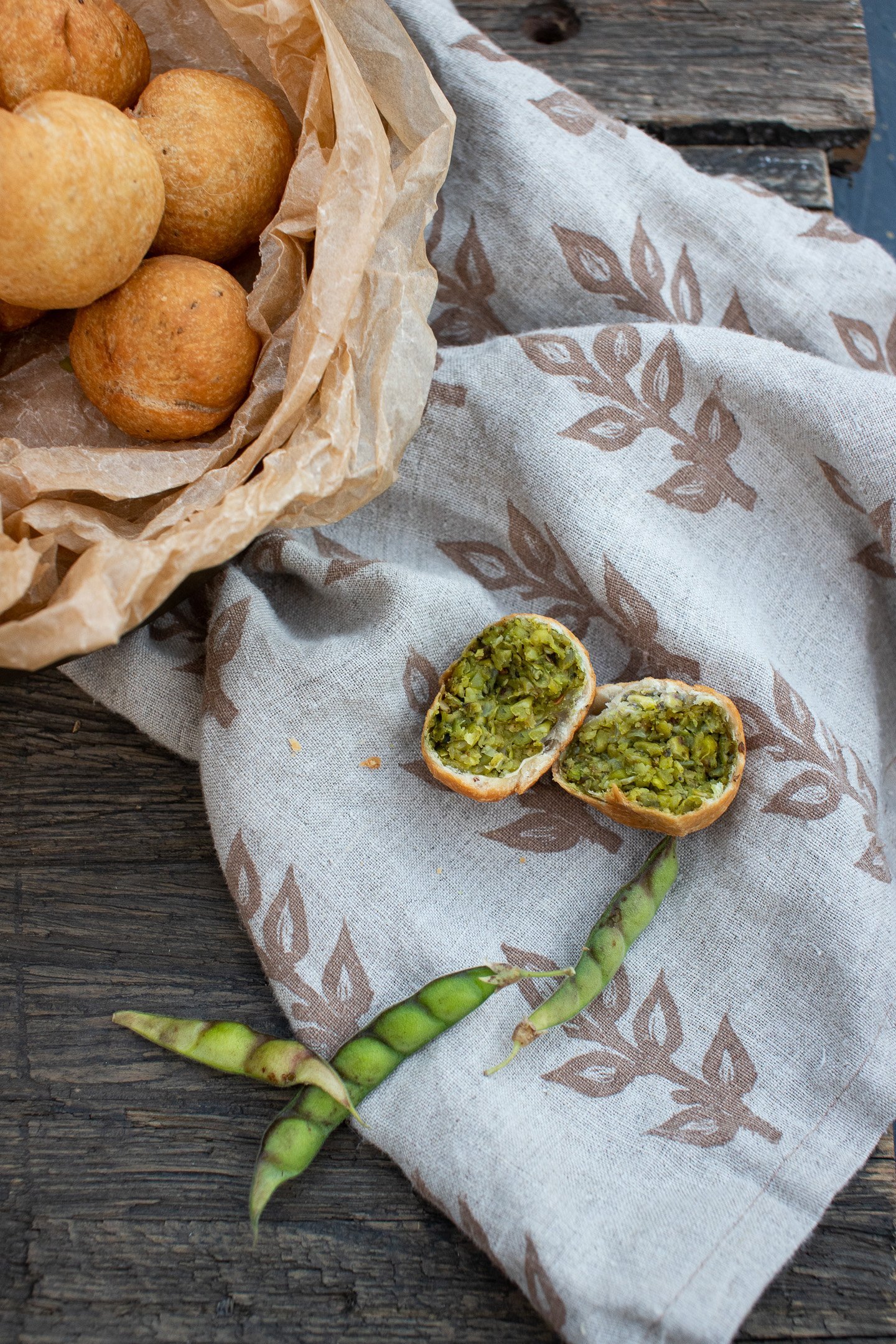
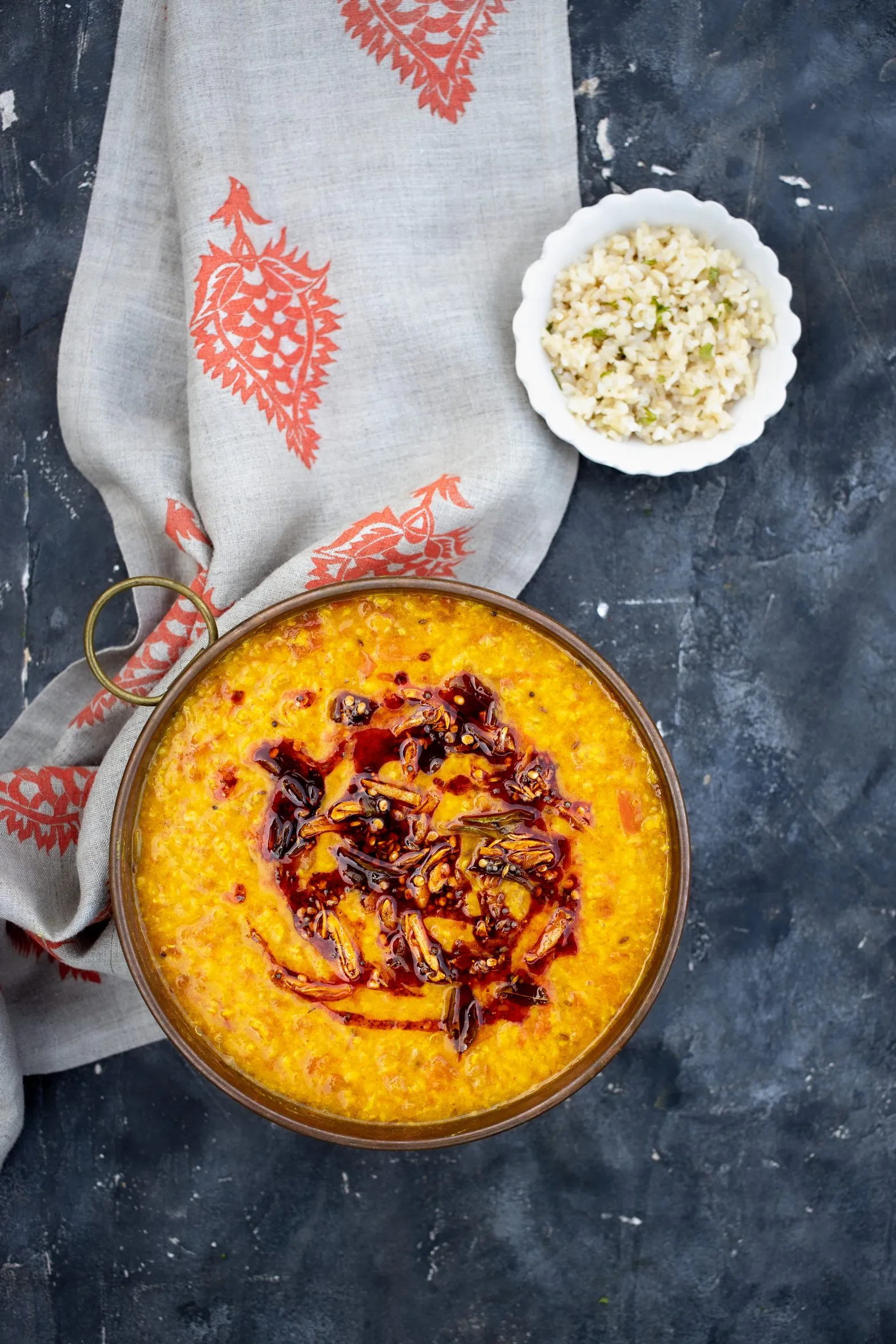
AMAZING post! Thanks so much for breaking down the cook times and cookers for each bean. Very helpful! =)
Thanks Elizabeth! 🙂 Glad it’s helpful!
Thank you so much for this! I’m an American vegetarian and am getting more into pulses, being home more in the pandemic. You gave me great information, thanks so much!
Thanks for writing this I have learned so much.
Very detailed and informative.learned a lot??
great picture , looks gorgeous ! useful post 🙂
Thanks Shruti!
Fantastic post!! People often ask me the difference between mung daal and mung bean..I will refer them to this post!
Thanks Snehal! I’m always being asked that too. This post has been in draft mode for more than an year. Finally finished it. 🙂
I could KISS you for this post!! This is AWESOME!! Just what I’ve been looking for.
Glad to be helpful, Christie! 🙂
This is an incredible resource. I learned so much about the different kinds of “pulse” and the differences between them. Working with beans and lentils has been a little daunting for me in the past so I am bookmarking this post for future reference. Thank you so much!
Thanks Barbara! I’m glad it’s helpful! 🙂
West of luck
All the East
Thanks for the in-depth guide. I just bookmarked it! I am most familiar with French lentils, but I am open to exploring the ones listed above. So many possibilities :)!
Thanks Brandon! French lentils are yummy too! Most of these lentils have an entirely different flavor. I’m sure you’ll enjoy experimenting with them. 🙂
Wow very informative Puja! One year in draft mode is a super long time! Also, can’t believe red beans are listed as toxic (though I usually don’t slow cook my beans at this time). I’ll make sure to come here when I need a bean guide!
Thanks Lynn! 🙂
One of the coolest photos I’ve seen, hands down. Very reminiscent of a constellation.
This was really helpful. I’ve been searching for a guide like this for a long while so thank you! One thing, though: Is a “gram” the same thing as a pulse?
Thanks Liz. I’m so excited that so many people are finding this post helpful.
The term gram is used for several Indian pulses like mung, garbanzo and urad. As far as I can tell it’s just a reference to pulses. Hope this helps!
Gram is a pulse generally called chana. Split- it’s chana dal n its flour is gram flour or chana flour or BESAN.
very useful post.
Thanks Gayathri! 🙂
nice photo’s ,a neat blog and so much of information it is so nice….
Thanks Marudhu!
This is very helpful for my new business to understand different between pulses and lentils. Thank You very much.
You’re welcome. Good luck!
Pooja thomas very good help me give a list of of all kathor. A heard there are 28 kathor are available.
very informative. i always knew i had my peas ,beans,pulses all mixed up.learnt alot today
Thanks Hanifa. Glad it’s helpful!
Very useful information. Definitely needed a break down like this. Thank you. 🙂
Thanks Maggie! 🙂
Your blog has inspired me to open a desi restaurant chain selling different dals only.. Dal-roti-chutni…like that of a McDonald/subway…
Many Thanks Puja, I am into export of Pulses , where we need to explain our clients the varieties of pulses but how they should make it was issues, which I think you have sorted out. otherwise I was teaching them only how to make “Rajma Chawal”. Thanks a lot for such a blog! Fully agreed to Robin’s Idea to make Desi food court
Just found your website recently and I have to say “What a great resource and information! I really want to expand my palate in Indian cuisine and this chart is helpful for those of use unfamiliar with Indian cooking. I looking forward making your recipes. Thanks..
Well my search for protein rich diet brings me here.
Awesome stuff! Me being an Indian and eating all these for years was still confused.
Thank you! Your post contains in a precise way — exactly what I was looking for. And I couldn’t figure out what “whistles” meant since I have a pressure cooker made in USA!
I still don’t know what “whistles” refers to.
Thanks,
Just saw it, sorry 🙂
A whistle is part of Pressure Cooker which produce sound when pressure in cooker is more than it can withstand. You have Pressure Cooker made in USA or made at Moon doesn’t matter. It will have a whistle.
Hi, I think you can help me out, I want to know the exact Gujarati Name of White Beans?
I am confused in Vaal or Valol.
I also always used to get confused between all pulses and dals. Now I know the difference between all.
Which dals are toxic? Can you name them. Very nice article.
I just made a dal for the first time in the slow cooker with mung beans. It was delicious! Thanks for all the tips!
Awesome! Glad you enjoyed it!
I was ready to throw out the whole urad dahl as a failed product. I treated them like mung beans. Thank you for your clarity and comprehensive review.
Hello from Newfoundland Canada.
Jim Andrews
Gr8 information, finally I know clearly about Garbanzo Beans and its flour :):) Thanks alot ..!!!
Extremely useful. I just moved to India and was amazed to see so many different types of beans and lentils. Now I know what they are. Cannot wait to try them all. Thanks.
Thanks for clearing that all up letting me know I eventually got it right. I’m new to Indian cooking and cooking with pulses and have been piecing together little things for over a year and still wasn’t 100% sure about things.
This is a great page and resource for others out there just staring out and a real time saver, as speaking from a personal perspective it can take a long time to work all this out yourself if you are coming in with zero knowledge like I did a year ago ( I wish I had this page back then!)
Your post is fantastic! Unfortunately, being very new to cooking Indian food, I’m still unsure and maybe you can clarify for me. Are mung beans also referred to as moong dal? 🙂
???
Hi Jodie – Sorry for the delayed response! Mung beans are the whole bean. Moong dal is the same bean that has been split. Hope this helps!
Yes! Thank you so much!
This is absolutely great! I’m translating an Indian cookbook and this is a lifesaver! Thank you!
Thanks Laura! Happy to be of help!
Hello, I’m on a low oxalate diet and can have legumes but not lentils… do any daals fall into the legume category?
Very useful post. I was thinking of writing one on pulses and searched to see if anyone had already done it. So, saved me lots of research and effort. Thanks.
Thanks Puja, had been the look out for right combination of lentils to be added to my diet and your writeup opens up the possibility of keeping it Indian and still have the trim low glycaemic meals.
Hi Puja,
This is great. Do you think you could do a similar guide on Indian chilis for cooking. My kids don’t like too much heat but I want to add flavor where I can.
Thanks,
Seema
Are these grains/dals available in USA?
Yes , Sumit I bought all of these in the US. Look for am Indian grocery store/ market. You can all but them online.
Now that is indeed an informative blog!
This is the most helpful version. I was so confused as to what was split/non-split/legume/lentil.
Thanks for the effort!
Thanks, Aretin! Glad I could be of help. 🙂
I knew most of this but i had no idea lal chawli was azuki. Every time I made a recipe, i substituted, thanks for the list.
Thanks very good information on various dals. If you add proten, minerals and vitamin contents I hope it is better. Similarly also mention vitamins and minerals distroid while cooking and how to retain them.
Thank you for this! My husband is allergic to lentils, peas, and kidney beans, but not to chick peas or mung beans. I was pretty sure that Urad Dal wasn’t a “true lentil,” but your list clarifies things further; i.e., that “lentil” is a loose translation of “dal” and refers to the lens-like shape and NOT necessarily the species. If you have room on a later chart, the Latin names of the various pulses might prove quite helpful for those trying to avoid particular species. Thanks again from BC, Canada, where indian pulses and spices are very readily available.
Glad to be of help! 🙂
HI , My name is Karuna, m newly married and my mother in law is great cook but learning from her its difficult as every indian household has different ways of cooking. So I m new to cooking and specially Dal is difficult.. firstly to identify which dal is what called in gujrati is so different.. your articles is actually very helpful for new bahu in kitchen like me.. Thanks alot for you post.
That’s awesome. Maybe I’ll add “impressing Gujarati mothers in-law” to the blog tag line! Anyway, congratulations on your wedding. Wishing you all the very best in your new life! 🙂
This is amazing..I asked my husband to bring Moong Daal and her got Toor, which was something very new for me, so I searched and after disappointed from Wikipedia, found this little but very comprehensive information…Good work!! Will visit your page over and over, have added in my fav.
Tanks for giving valuable information’s on cooking.
I have a doughty that some times you mention Lentils as beans or pulses, some times Lentils as Masoor dal, if Masoor is Lentils then don’t use the word Lentils at all. If Lentils is different, please give photograph and explain about Lentils.
Your website about beans/legumes, dal, etc., is great. There is one big problem, I want to live in India now that I am retired, but I find it too expensive to travel there from the Philippines, originally from the USA. I like lentils, mung and all other legumes. Your fotografs are great and make a person hungry.
Hi Tiko, Thanks for your comment. I hope you get a chance to move to India someday soon. 🙂
Puja
lovely explanation really very helpfull
manoj jetley
I was looking to find info on how Pigeon Peas the are green turn to Yellow when dried. It led me to this article. Very informative, but yet it doesn’t answer my question. Please reply if anyone knows.
wonderful !!
THANK YOU i WAS WONDERING WHAT IT ;MEANS MOONG DAL BUT I FOUND MORE EXPLANATION THAT HELPS ME TO NOW MBETTER
Although we are traders of dals and pulses, but this was a real eye opener for us as-well. Thanks Puja Thomas Patel for the great article.
Thank you Puja for this.. I’ve taken a photo of the cooking times for all the daals.. Extremely simple and informative.. I’ve been wondering about all these dals for years and slowly branching out to try new ones.. Given a great new boost of confidence. Thank you again
Thank you for your thorough explanation of the dals! I’ve always wondered about the cooking times. Would it be possible for you to add the stove-top cooking times since so few of us in the U.S. have pressure cookers (us non-Indians anyways).
Hi Cheryl! I’m glad this is helpful. The stove top cook time is actually up. That’s what I mean by cook time.
Thank you! So helpful, as an Indiaphile I needed to know specifics! All are so delicious!
Thank you so much for this post, it has really helped.
Hey Puja! I find this quite informative. Thanks for sharing.
In the article, you have mentioned “Pulses are also soaked and then ground into a paste (often with soaked rice) to make dishes like dosa and idlee”. I assume that you are referring to wet grinding of the soaked pulses and soaked rice together to make a paste. Is it possible to create the same paste by using ground pulses’ powder and ground rice powder?
very nice !! helped me in my project work….thanx !
Great post!! I am allergic to lentils and chickpeas, and I can only have “pulses” like mung and urad. But after reading this post I am beginning to think maybe I can try pigeon pea also, since you wrote that its a pulse, or did I misread it? I will also try Black Eyed Peas and Azuki Beans as the shape of them are not round like normal lentils which I cant have. Thanks again!!! This is by far the best guide I have seen on lentils 😀
Thanks for giving information about pulses it helps me in my science project file
lovely presentation . mouth watering urad dal
great info.. thanks for the post.
I just found your site and wanted to thank you for such an enlightening post. I was looking for a recipe on rava upma and just happened along your blog. Looking forward to exploring it more. Thanks!
I came here trying to figure out the Indian name for what are marketed in America as “yellow lentils.” I think it’s tuver dal? If true, it might be worth a reference in this post; I can’t easily find another place that does the translation.
I had asked difference of nutrients in Moong whole and chick peas (humus)
Excellent write up, I need to enhance the content i have truly.
I have attemptedto blog on third part systems, it just did
not transpire the true way I wanted it to. But your website has
providing me a desire to do so. I will be bookmarking your website
and checking it out from time to time. Thank you!
The comment on age of the dried pulses and cooking time is critical. For western cooks that may make Indian food as well as non-Indian food, using these items may result in half a package of an item to sit in a larder for months after purchase. So the comment on cooking times and the need for soaking is probably most relevant for open packages. It does raise a couple of questions about, “how old is old?” for items that are described both in terms of storage in warehouses and retail stores as well as our larder. I’m now somewhat convinced that most dried items are older than we think and take longer than we think as well.
What is channa dhal? Does it need soaking overnight?
Thank You
Art
This is a great article, very helpful, thank you.
I really appreciate the time and research taken to make this informative website. Being newly diagnosed with type II diabetes, I am sure this will help me to improve my diet.
Cheers
Thanks so much for posting this. You answered so many of my questions. Whenever I go to an Indian or Oriental market I’m like a kid in a toy store. Everything looks so wonderful. I buy buy buy and get home and don’t know half of what I have or what to do with it. This article helps a lot.
I would love to see that table with images of the dals next to them so i could print and keep in my kitchen. Thank you for this eye opening read.
Hi,
Is matki dal same as Urad dal, because both looks same? Thanks
Great resource! You mention that some beans are toxic if not cooked, but I don’t see a list of those or a reference to toxicity in each description or in the cooking chart. Please add this detail to make this the only page a person needs to visit for complete information on lentils, beans, and pulses. Thank you!
Just starting with Indian cooking and this was best explanation I found on the dals. Thanks so much!
Many thanks for this site. it really helped me to understand the difference between all the legumes. I have a great book on Ayurvedic foods but it didn’t give any info about the different types of dal.. quite confusing. You have cleared this up. Many thanks
A recipe I’m looking at asks for ‘Thur Dahl’ – I”m confused and so is Google. 🙂 Can you help? Is it possible the book has spelt it wrong and it should say ‘Toor Dahl’ or what exactly am I looking for? Thank you so much.
Hi Isabel! That sounds like it would be toor dal. There is a huge variation in the English spellings of words that are originally in Hindi (or any of the other Indian languages) because the Indian languages are written phonetically.
If you can tell me what the recipe is, I can further confirm what lentil it would traditionally call for.
Thanks so much for this article. I cook Indian dishes all the time and have slowly worked some of this out for myself, but it is great to have all the information summarised in one place. The next recipe I want to try is a South Indian peanut podi, and the recipe calls for gram putani. I am having a lot of trouble finding our if this is a specific pulse or… What? Can you help?
This is a FANTASTIC post! I’m getting deeper and deeper into Ayurveda, and so into a lot of marvelous Indian foods, spices, and ways of preparing food.
The chart is one of the best I’ve ever come across online. Would you happen to have comparable soaking and cooking times for Pinto beans and black beans?
Thanks again!
Thank you for the descriptions.
Hi Pooja, thanks for this great article. After mom passed away I have had to learn to cook Indian food for my papa and this is a great help. One thing that has been bothering me about making dal-sometimes I am getting a skin forming on the top of the dal. Like how hot milk forms a skin on top. I’m guessing it’s from the spices (chilli, turmeric, etc) Any tips on how to avoid this? Thanks again
Thanks for the guide. It is indeed a great job. My first time to try pulses yellow deal and a little confused on how to make a ditch out of it. This article has guided and equip me fully on the varieties and ways to do the culinary…….Blessings
THANK YOU!
This is the best of the assorted sites google offered when I searched for “urad dal” — you tell me everything I needed to know — and more.
With no ads, even!! You rock! Thank you for your research, experience, and generous service to anyone who might need to know.
Love the informative post! Great photos too. Would just like to mention that kidney beans only need to be boiled for 10 minutes to kill the toxicity. 30 minutes won’t harm them though since they take so long to cook anyway. Also it’s a myth that if you add salt prior to cooking the pulses they won’t soften. There are many experiments online if you are interested in the science behind it but it’s safe to salt while cooking and in fact is preferable! Lastly.. after finally getting my hands on a pressure cooker, I have to admit the flavour of all pulses is far superior when cooked with it. I used to cook my pulses on the stove top and along with taking an extremely long time, I find they loose a lot of flavour in the process. When cooked in the pressure cooker they retain so much of their flavour! It doesn’t leach out into the cooking liquid I guess. Each person should try for themselves 🙂
I have been trying to find the alternative name for Dal Maash, a standard Pakistani dish. My memory suggests it is Channa dal, but the only reference I have found is to White Dal ( which I imagine to be Urad ?).
Can you help
I have a question on on Urad (sp?) dal….I generally gring my own wheat and was wondering if it were possible to grind the black lentils myself for use in my wet/grindet. Or would it be cheaper to just buy the flour already ground? I found a brand new wet grinder, still in the box at an estate sale for $10.00…!! A tremendous deal, it had never been used…so sounds like a perfect time to learn how to cook some Indian basics?
SUPER helpful. Thank you very much 🙂
Brilliant, understand so much more than I did and won’t feel like such an idiot when I do my sop at In dian supply store!
Thank you
This is an excellent resource. Especially since the western names are often country specific and the Indian names vary in spelling and by language. I think the scientific names would make this list complete!
Thanks for putting this together.
HI,THANKS FOR ELABORATING ,THUS I UNDERSTAND THE LENTILS ARE ONLY MASOOR AND URAD RIGHT? BECAUSE I HAVE BEEN ADVISED TO BE OFF LENTILS AS IAM ALLERGIC TO THEM
This site is worth it’s weight in gold…I am vegetarian/vegan and started shopping at Indian stores several years ago…Thankyou for simplifying the bean/pulse /dal questions…Wonderful information..I understand why it took a year….Thankyou again..
these “pressure cooker whistles ” number is great.
I know that this blog post was published some time ago, but I wanted to print the cooking chart, and thought other people might also appreciate a printable version. Thank you for this resource!
Google Doc of Table
What’s the difference between urad and udid dal
Thank you for the conversion help between pressure cooking and stovetop cooking, as well as the recommended soaking times. Extremely helpful to a western novice!
Thank you! So much great information!
Wow this is mind blowing article fully packed with factual information.
Thank you so much for writing this.
If you get some time to update this article with nutrition values of each of the pulses, it would be awesome too.
Thanks again!
Hello Puja. What pressure do you use for pressure-cooker? Mine will do 5, 10 or 15psi depending on which weights are used.
Thank you very much. Very Well explained. Ur post is very helpful to me.
What an amazing and informative post. Thanks for sharing Puja!
I was confused between dal and lentils. I have noticed that nutrition values, especially protein for lentils is way more than that of dal. That suggests that vegans could prefer lentils over dal to hit their daily protein requirements. Also, interesting to learn cultural aspects of food.
As soon as I found this website I went on reddit
to share some of the love with them.
Thank you for the excellent information and facts, this was a very good piece of writing.
I needet the typ of spices to add to daal out of onions.
this seems a complicated question.have a nice day –eat your webside-bon appetite
I just found your blog and I wanted to thank you for this table of cooking (stove-top) and soaking times! So often it is difficult to find out how long to cook on stove top if using a dal/lentil uncommon in the West.
Thank you so much Puja for the information, so helpful.
Glad it was helpful!
Brilliant – at last something written that looks like things my mum used to make!
Awesome! These are the foods my mom and grandma made and so happy to hear that you share a similar food history. 🙂
These are the best source of Iron and are also good for health as well. I found this article very helpful thanks for sharing.
Hi Sofiya,
Happy to hear that you found this post helpful. Thank you for taking the time to let me know!